Istanbul’s landscape is a fascinating tapestry of religious architecture, primarily Istanbul churches and synagogues, reflecting the city’s complex and layered history. From the grandeur of formerly Orthodox cathedrals like Hagia Sophia, later converted to a mosque, museum, and again a mosque, to the more modest but equally significant Armenian Apostolic churches and the diverse array of synagogues, each structure tells a story of the communities that have called Istanbul home. These buildings are not merely places of worship; they are physical embodiments of the city’s multicultural heritage, showcasing a variety of architectural styles and artistic traditions. These diverse religious structures speak to the historical shifts in religious dominance and the ebb and flow of different communities within Istanbul.
The religious history of Istanbul has been marked by periods of tolerance and restriction. Under Byzantine rule, it was a center of Eastern Orthodox Christianity. The Ottoman conquest in 1453 brought about a transformation, with the conversion of many churches into mosques and the rise of Islam as the dominant religion. However, the Ottoman Empire also generally practiced a degree of religious tolerance, allowing for the continued existence of Christian and Jewish communities, though often with certain restrictions and varying degrees of social and political equality. The secularisation policies of the modern Turkish Republic further reshaped the religious landscape, impacting the role of religion in public life. Despite these changes, Istanbul remains a city where different faiths coexist, contributing to its unique cultural richness. Istanbul’s historical significance as a center of Christianity and Islam, and its continuing importance to several faiths, makes it a major religious centre worldwide. Its role as the seat of the Ecumenical Patriarchate of Constantinople gives it particular significance in the Eastern Orthodox world.
Istanbul Top 10 Churches & Synagogues – Table of Contents
Top 10 Active Istanbul Churches & Synagogues
Church of St. George (Aya Yorgi) – Reconstructed in 1797, Eastern Orthodox
Location: Aziz George Katedrali, Yavuz Sultan Selim, Dr. Sadık Ahmet Cd. No:19, 34083 Fatih/İstanbul. The official church website (Greek only). Opening Hours: Daily: 08:30 – 16:00 (subject to change due to religious events). Entrance Fee: Entry to the church is free.
Notes on entry & services: The Church of St. George is generally open to the public, but visitors should be aware of security measures, usually involving passing through a security check, including metal detectors and bag scanning. The church holds daily services, including Orthros (morning prayer), Vespers (evening prayer), and Divine Liturgy on Sundays and feast days. The main religious holidays celebrated at the church include Christmas, Easter, and feasts dedicated to notable saints in the Orthodox calendar. It’s always advisable to check the church’s official website or contact them directly for the most up-to-date information on visiting hours and service schedules.
The Church of St. George, also known as Aya Yorgi, Aziz George Katedrali, and the Venerable Patriarchal Church of Saint George, is a significant historical and religious site in the Fener district of Istanbul. It serves as the seat of the Ecumenical Patriarchate of Constantinople, the spiritual leader of the Eastern Orthodox Christians worldwide. While the exact origins of the church are debated, its history dates back to the Byzantine era. However, the current structure primarily reflects a reconstruction effort in 1797 under Patriarch Gregory V, following a devastating fire in 1738.


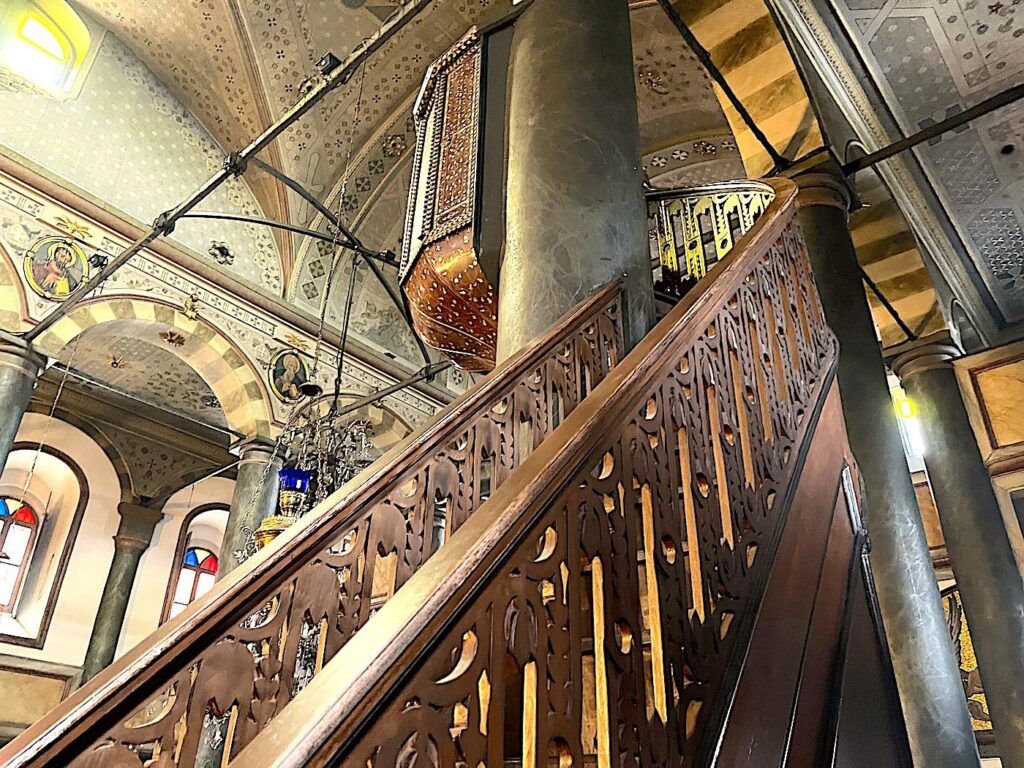
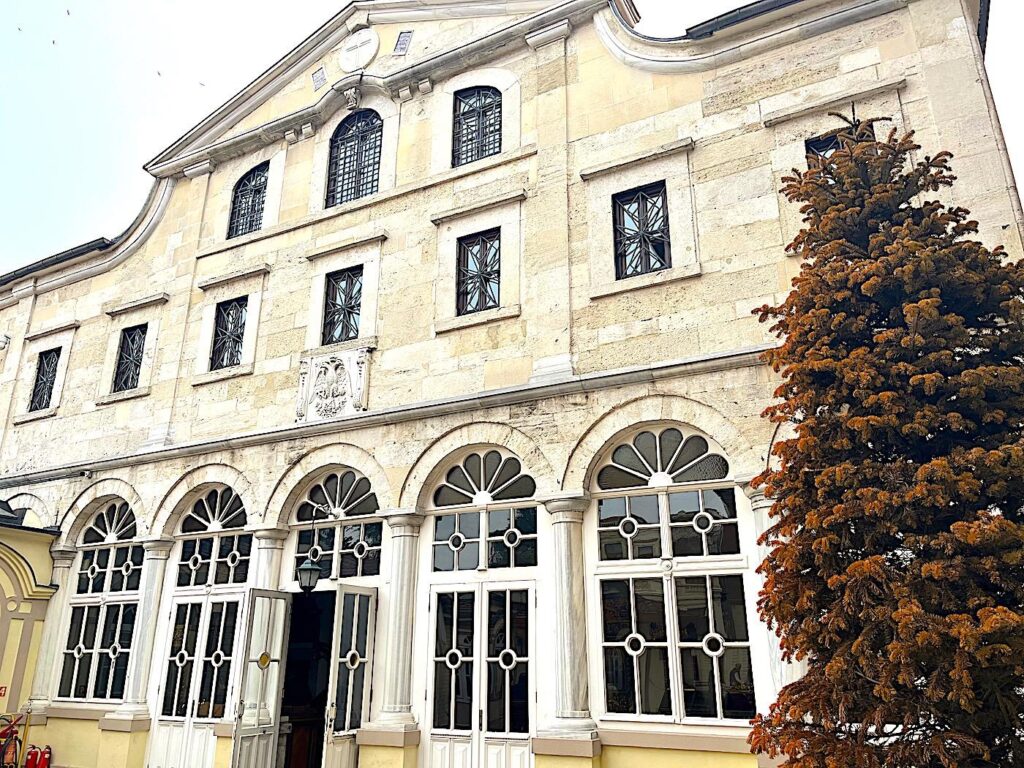

The Church of St. George is a relatively modest structure, especially considering its immense religious importance. Its architecture features a basilica plan with three aisles and three semicircular apses. A notable feature is the ornate wooden iconostasis, a screen covered in gold leaf that separates the nave from the altar. This iconostasis, crafted in the 18th century, showcases a blend of Byzantine, Renaissance, Baroque, and Ottoman artistic influences. Inside, the church houses several significant relics, including the patriarchal throne believed to date back to the 5th century, and relics of Saints Gregory the Theologian and John Chrysostom. The church’s religious significance stems from its role as the centre of the Ecumenical Patriarchate, making it a crucial pilgrimage site for Orthodox Christians. It is where the Ecumenical Patriarch conducts services and consecrates the chrism (myron) used in sacraments throughout the Orthodox world.
Church of St. Anthony of Padua – Reconstructed in 1912, Roman Catholic
Location: Sant’Antonio di Padova/St. Antuan Kilisesi, Tomtom, İstiklal Cd. No:171, 34433 Beyoğlu/İstanbul. The official church website is not functioning. Opening Hours: Daily: 08:00 – 19:30, except Sunday 09:00 – 18:30, and Tuesday 07:00 – 19:30. Entrance Fee: Entry to the church is free.
Notes on entry & services: Sant’Antonio di Padova is generally open to the public. Daily Masses are held in several languages, including English (Daily: 08:00, except Sunday 10:00, not on Tuesday), Polish (Sunday 11:00), Italian (Sunday 11:30), and Turkish (Daily: 19:00, except Sunday 18:00, and Tuesday 11:30). A special prayer service dedicated to St. Anthony is held every Tuesday at 11:00. All time aresubject to change. Major religious holidays celebrated at the church include Christmas, Easter, and the Feast of St. Anthony of Padua on June 13th.
Sant’Antonio di Padova, located on İstiklal Street in Istanbul, is the largest Roman Catholic church in the city. While an earlier church existed on the site, the current structure was completed in 1912. It was commissioned by the Italian community of Istanbul, who had a strong presence in the area. The architect was Giulio Mongeri, an Italian-Levantine architect who designed several other notable buildings in Istanbul, showcasing a blend of architectural styles. The church’s design is primarily Venetian Neo-Gothic and Tuscan-Lombard, a somewhat unique style for Istanbul, reflecting the origins of its patrons.
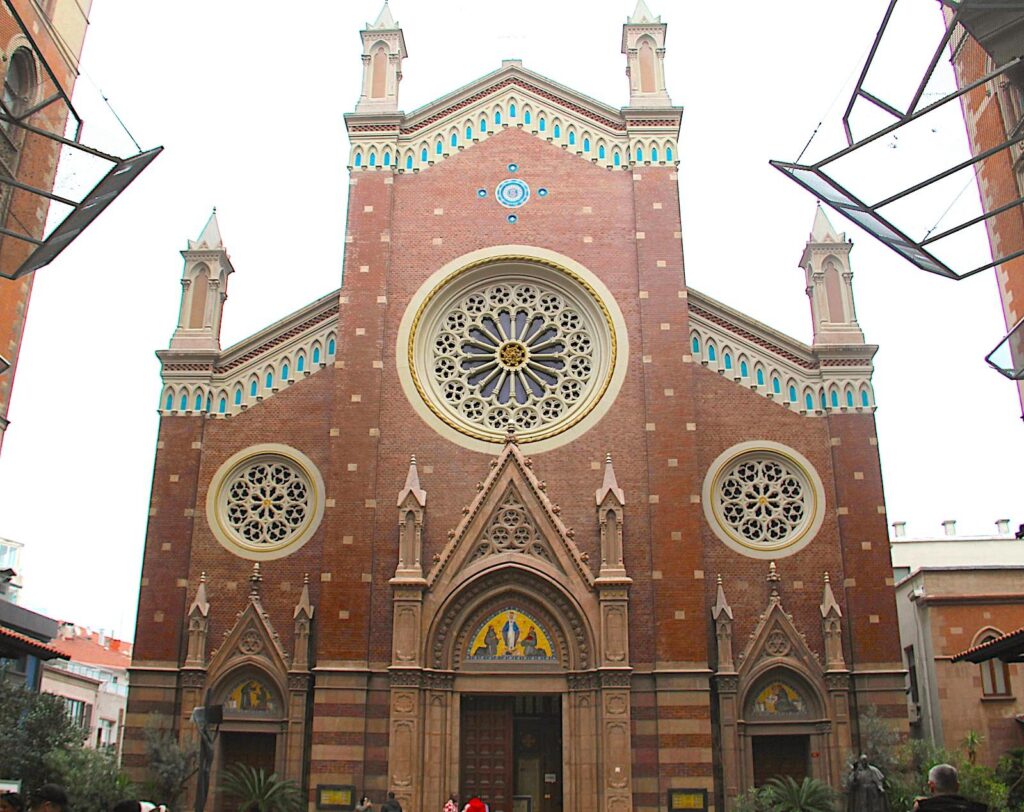

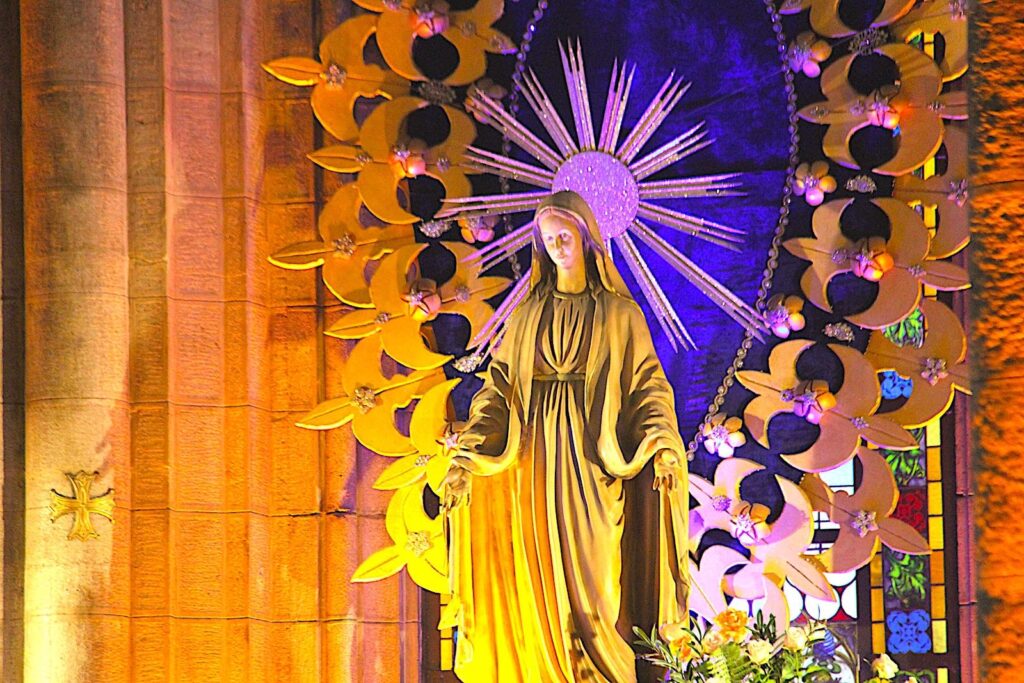
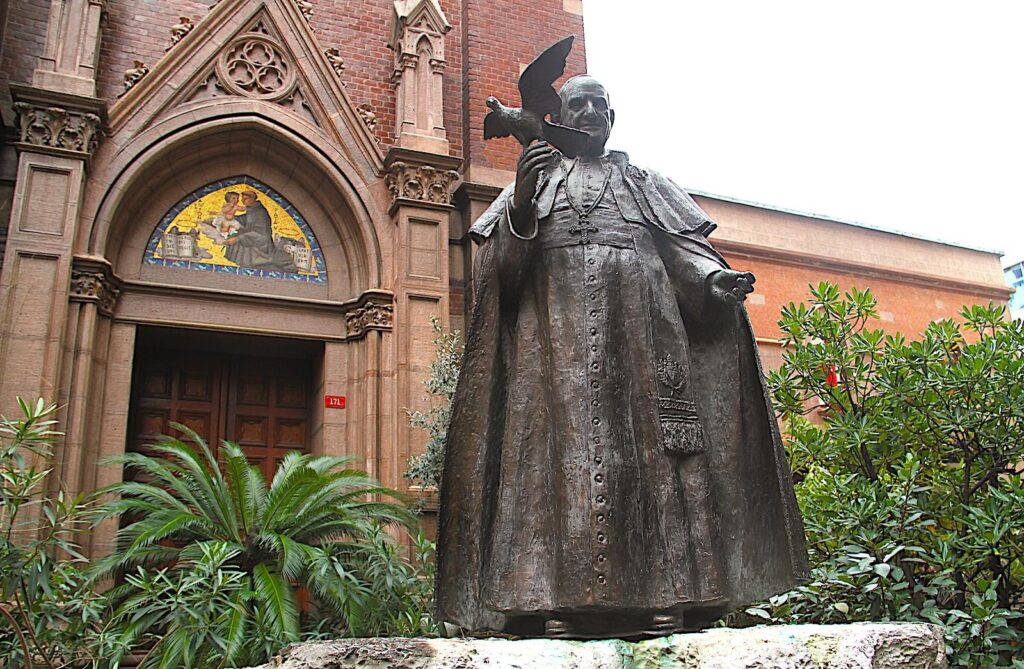
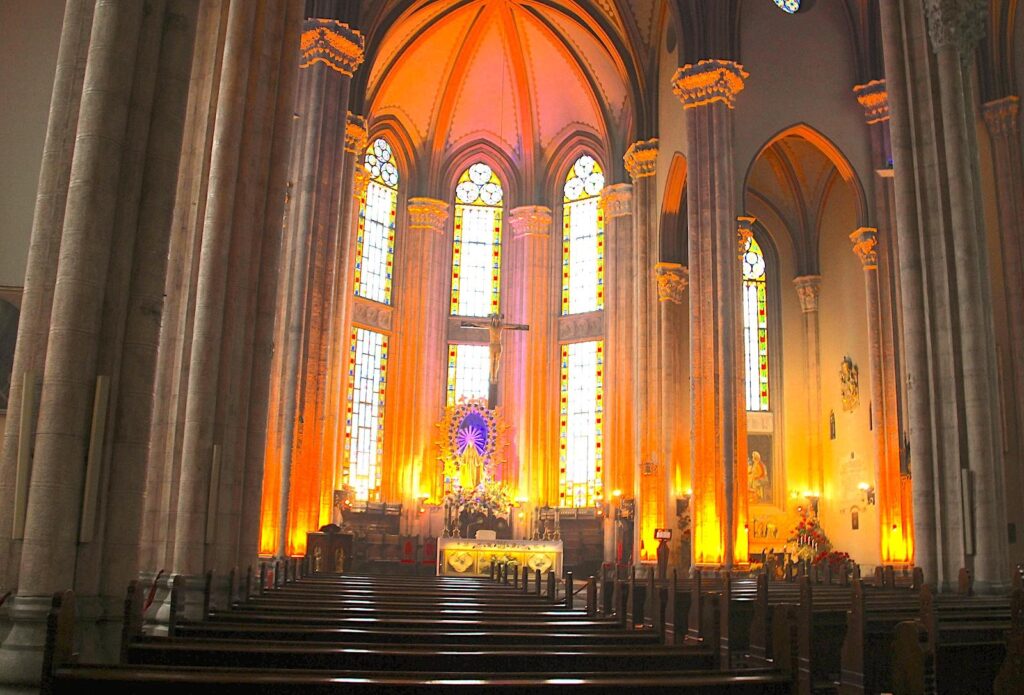
The Basilica di Sant’Antonio di Padova features a prominent bell tower and a striking rose window above the main entrance. Inside, the church boasts three naves adorned with frescoes and mosaics crafted by Italian artists. The three marble altars are dedicated to St. Anthony of Padua, St. Francis of Assisi, and St. Clare. The church holds significant religious importance as a major center of Catholicism in Istanbul and is particularly associated with St. Anthony, the patron saint of lost items. Its historical significance is further enhanced by the fact that Pope John XXIII, the “Good Pope”, served as the Vatican’s ambassador to Türkiye and preached at this church for ten years (November 1934 to December 1944) before becoming Pope in October 1958. His statue stands close to the main doors of the church.
Church of St. Mary Draperis – 1769, Roman Catholic
Location: Santa Maria Draperis Kilisesi, Tomtom, İstiklal Cd. No:215, 34433 Beyoğlu/İstanbul. The official church website. Opening Hours: Daily: 10:00 – 12:00, 13:00 – 18:00 (contradicts mass schedule below). Entrance Fee: Entry to the church is free.
Notes on services: Daily masses are held in Italian Monday – Friday 08:00, and in Turkish on Saturdays 08:00. On Sunday, 09:00 in Italian, 10:00 in Korean, 11:15 English & Italian, and 18:30 in Spanish. Every last Sunday of the month, there is a single mass in multiple languages at 10.30 am.
The Church of St. Mary Draperis, located in the Beyoğlu district of Istanbul, has a long and complex history. While the origins of a church on this site date back to earlier Byzantine times, the current structure was completed in 1769. It was commissioned by the Franciscan Friars Minor, who have maintained a presence in Istanbul for centuries. The church’s name, “Draperis,” refers to the draper or cloth merchant, likely reflecting the area’s commercial past or a specific benefactor.
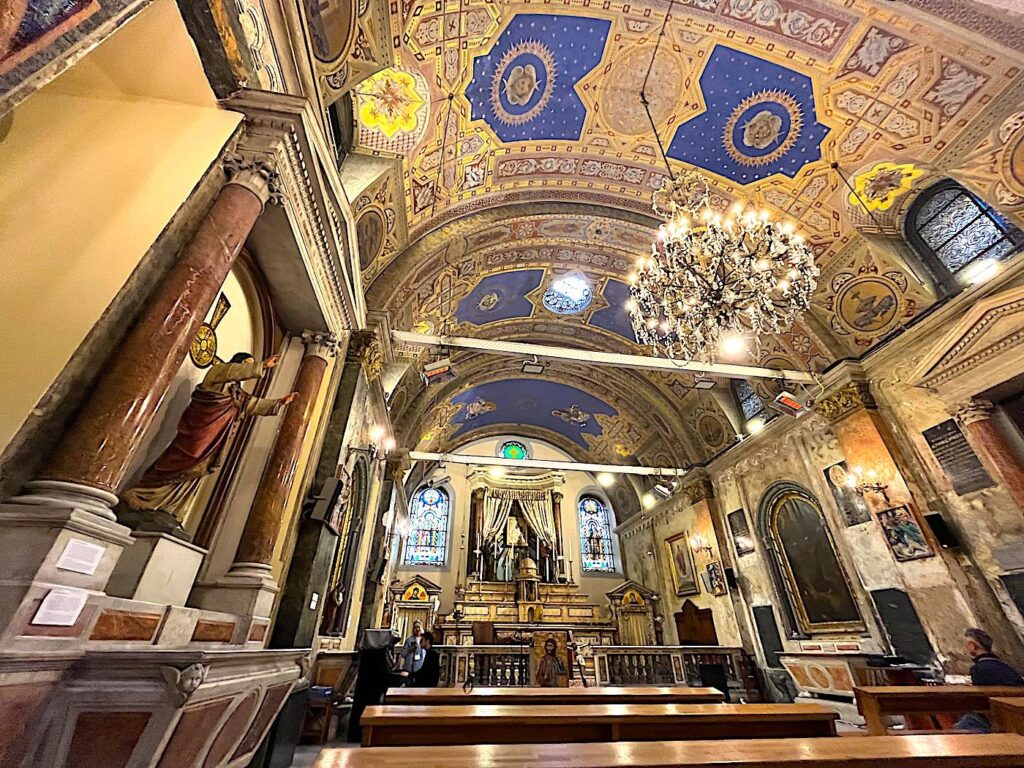


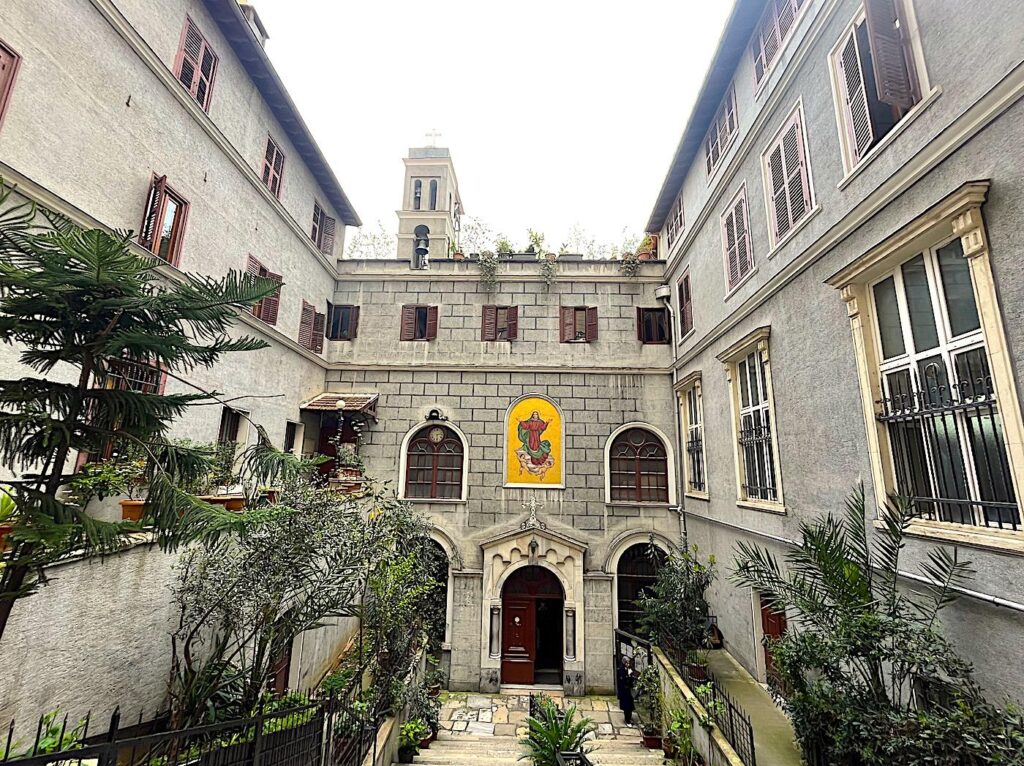

The Church of St. Mary Draperis is a relatively unassuming structure from the outside, blending into the surrounding urban landscape. However, the interior holds significant artistic and religious value. It features a single nave and is decorated with several important icons and paintings, some of which are believed to date back to the pre-1769 church. The church’s religious significance lies in its role as one of the oldest active Roman Catholic churches in Istanbul and its connection to the Franciscan order. It has served the local Catholic community for centuries, weathering various periods of change and challenge.
Hagia Triada Church – 1880, Greek Orthodox
Location: Aya Triada Rum Ortodoks Kilisesi, Katip Çelebi Mah., 34433 Beyoğlu/İstanbul. No known official church website. Opening Hours: Monday-Saturday: 09:00 – 18:00, Sunday 09:00 – 13:00. Entrance Fee: Entry to the church is free.
The Hagia Triada Church, meaning “Holy Trinity,” is a prominent Greek Orthodox church near Taksim Square in the Beyoğlu district of Istanbul. The current structure was completed in 1880, built on the site of a former Greek Orthodox cemetery and an older, smaller church. Its construction was commissioned by the Greek Orthodox community of Istanbul, with the designs attributed to architect P. Kampanaki, although some sources mention Vasilakis Ioannidis Efendi as the builder. The church is a significant example of Neo-Baroque architecture with elements of a basilica, featuring twin bell towers, a large central dome (a rare feature for Christian churches in Istanbul at the time), and a neo-Gothic facade.

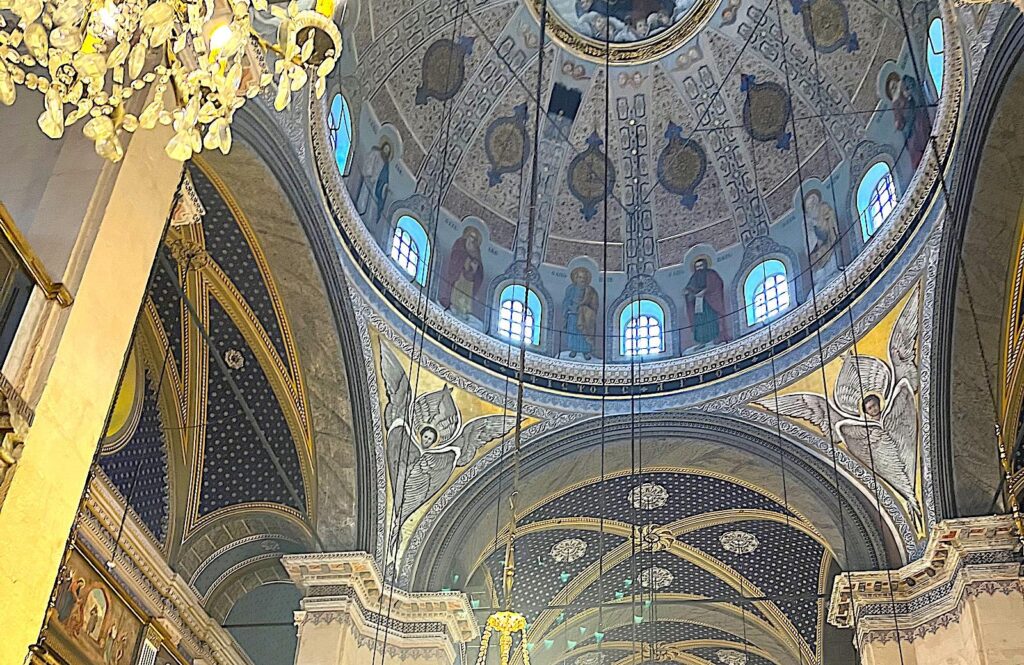
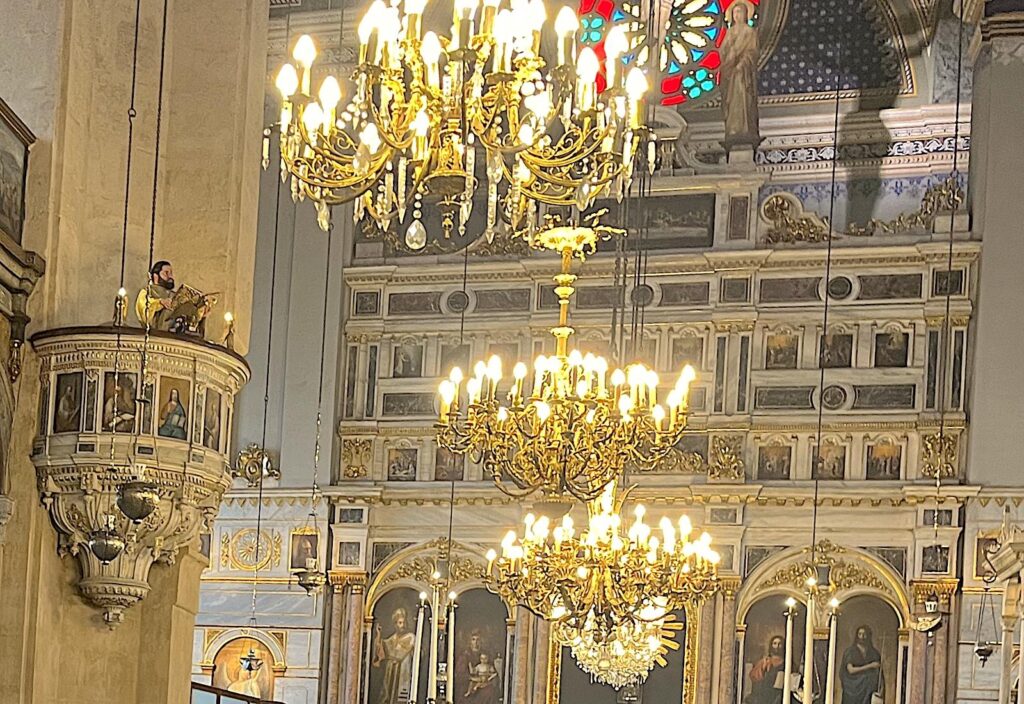
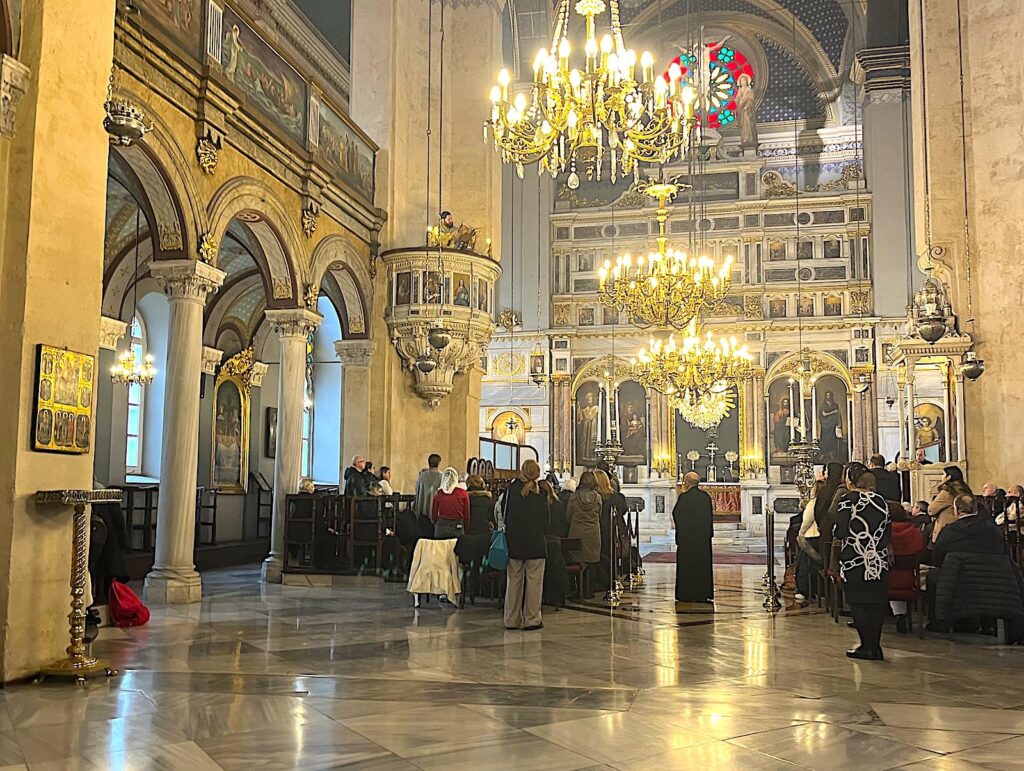
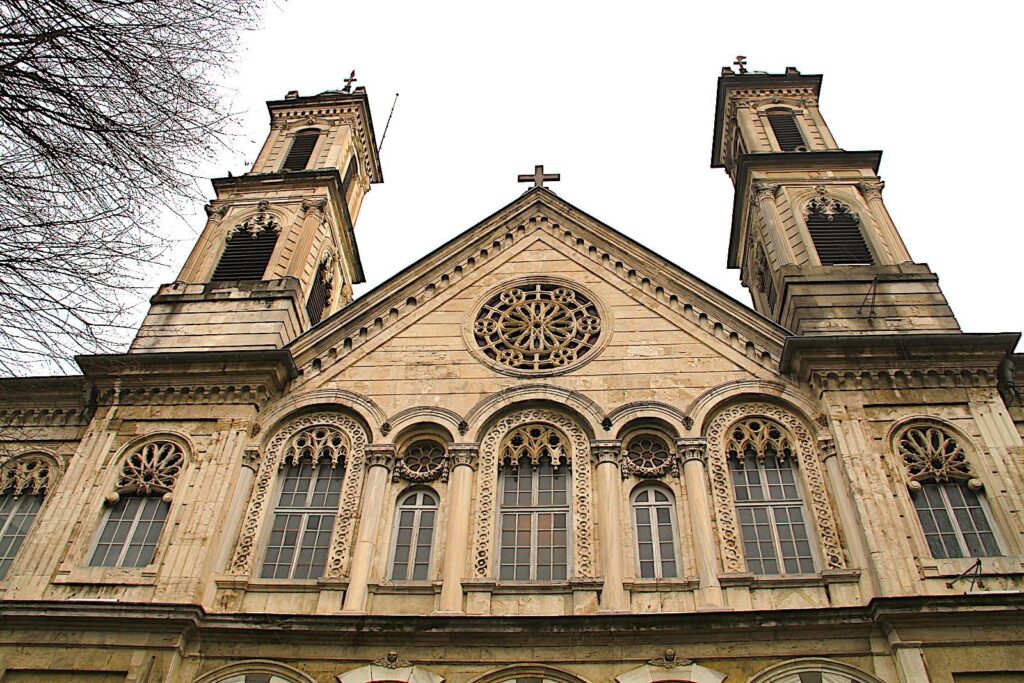
Hagia Triada Church holds considerable religious importance as the largest Greek Orthodox church in Istanbul today. It serves as a vital center of worship for the remaining Greek community in the city. It is known for its beautiful interior, adorned with frescoes and intricate decorations by painter Sakellarios Megaklis and sculptor Alexandros Krikelis. The church’s dome, a notable architectural achievement for its time, symbolises the Holy Trinity and reflects the theological significance of the church.
St. Stephen Church – Reopened 1898, Bulgarian Orthodox.
Location: Sveti Stefan Kilisesi (Demir Kilise), Balat, Mürselpaşa Cd., 34087 Fatih/İstanbul. The official church website. Opening Hours: Daily: 09:00 – 17:00. Entrance Fee: Entry to the church is free.
St. Stephen Bulgarian Church, also known as the Iron Church, is a unique and historically significant Bulgarian Orthodox church located on the banks of the Golden Horn, in the Balat district of Istanbul. The original wooden church on the site burned down, and the current church was consecrated in 1898. It was commissioned by the Bulgarian Exarchate, which had gained autonomy within the Ottoman Empire. The most remarkable aspect of St. Stephen’s is that it was prefabricated entirely of cast iron in Vienna, Austria, and then shipped in pieces to Istanbul to be assembled. The architect was Hovsep Aznavor, an Ottoman Armenian architect of the time. This unusual construction method was chosen due to the challenging terrain and the desire to create a distinctive and symbolic structure.
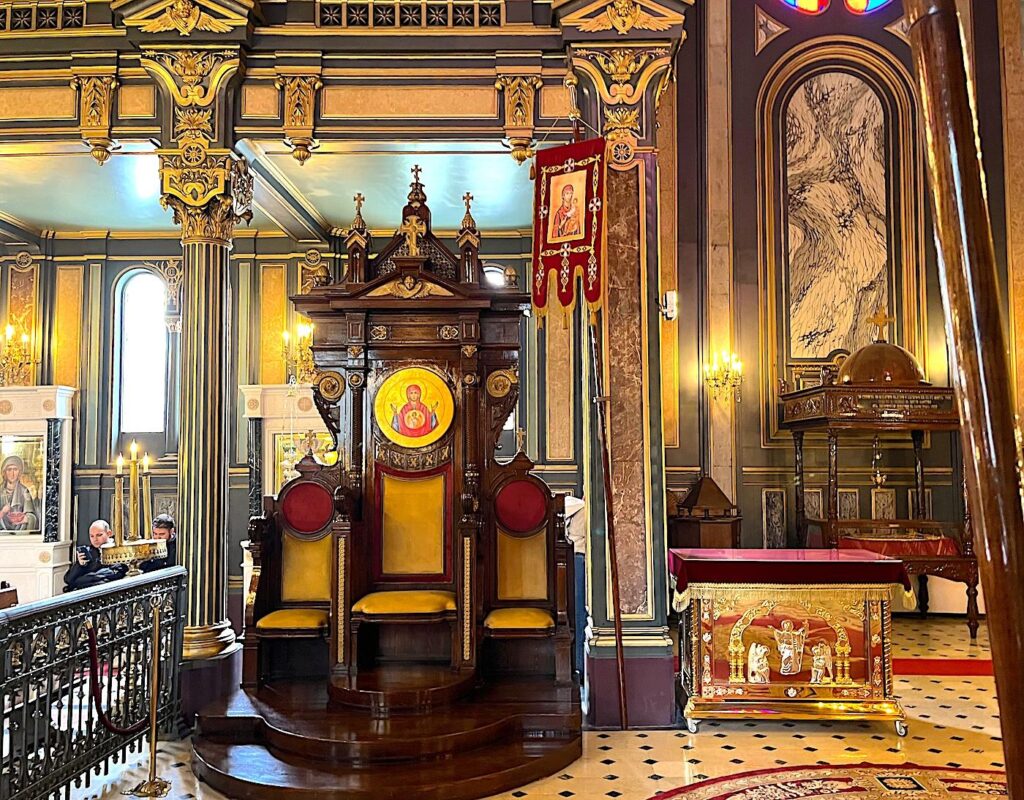
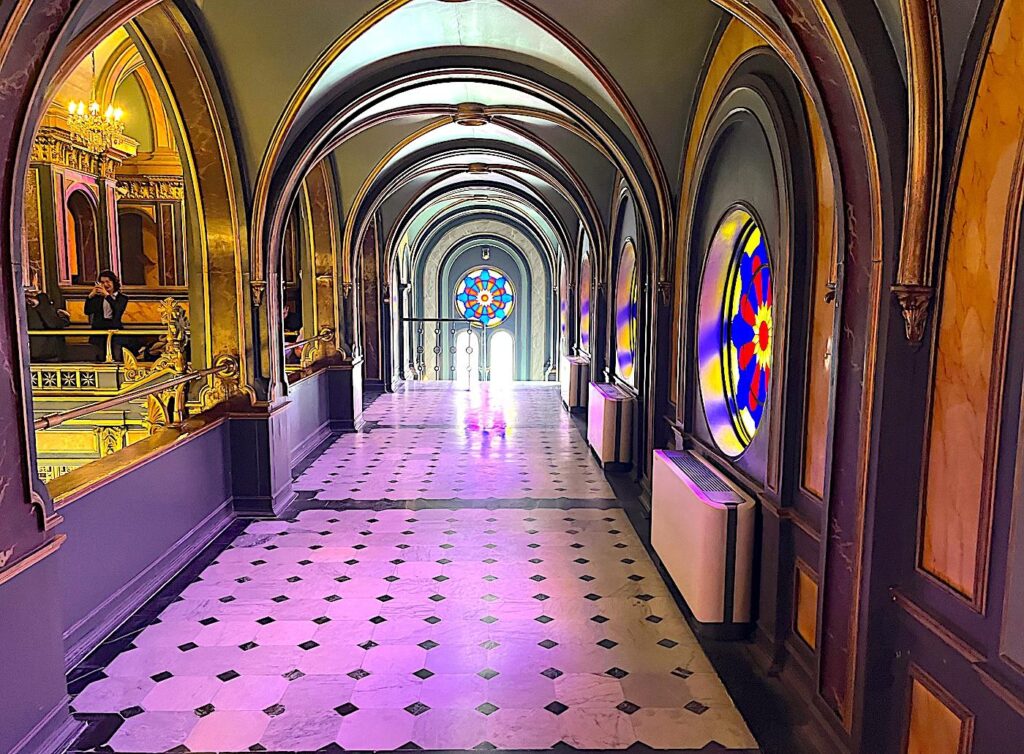

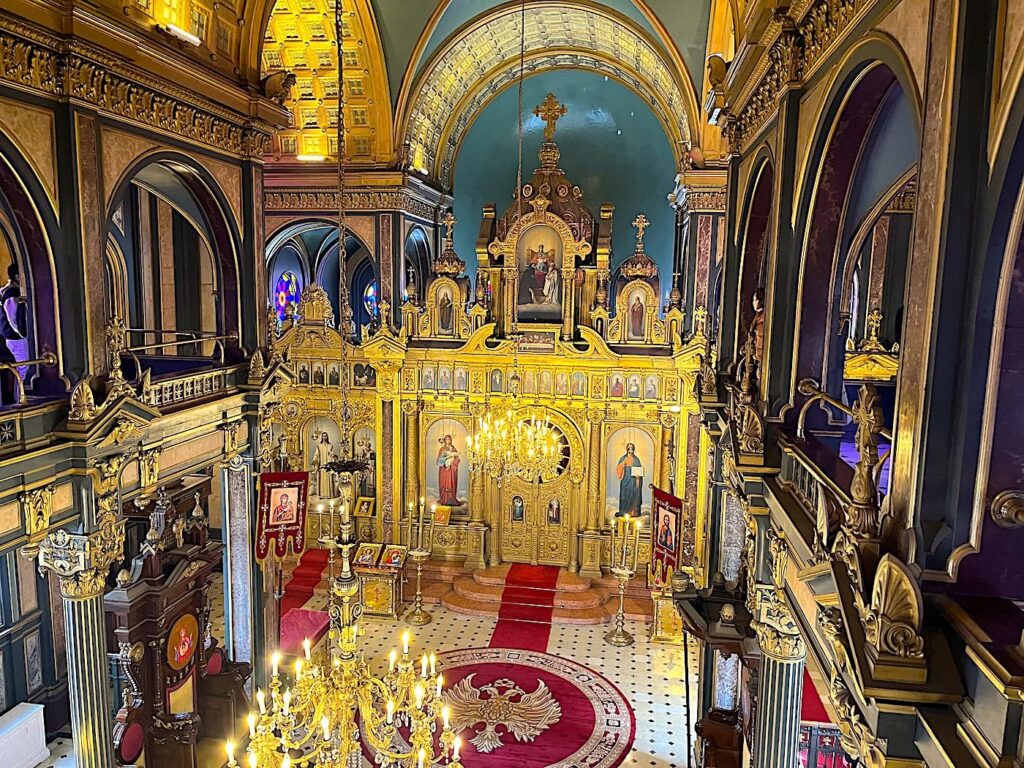

The entire structure, from the walls and columns to the decorative elements, is made of iron, giving it a unique appearance. The church features a central dome and a bell tower, and the intricate ironwork creates a delicate and ornate facade. Inside, the church is adorned with icons and religious paintings, contrasting with the industrial exterior. St. Stephen’s holds significant spiritual importance for the Bulgarian community in Istanbul and symbolises their cultural and religious identity.
St. Mary’s Patriarchal Church – Reconstructed 1828, Armenian Apostolic
Location: Kumkapı Meryem Ana Patriklik Kilisesi, Muhsine Hatun, Sevgi Sk. No:5, 34130 Fatih/İstanbul. No known official church website. Opening Hours: Daily: 09:00 – 17:00. Entrance Fee: Entry to the church is free.
The Kumkapı Meryem Ana Patriklik Kilisesi, meaning “St. Mary’s Patriarchal Church,” is a significant Armenian Apostolic church in the Kumkapı district of Istanbul. While the exact date of its original construction is unknown, it’s one of the oldest Armenian churches in the city, with a history stretching back centuries. Originally a Byzantine church, it was designated the patriarchal church for the Armenians of Istanbul in 1641. In 1645, a major fire destroyed the church, which was rebuilt the same year during the tenure of Patriarch Tavit Areveltzi, with efforts led by a cleric from Divrik named Boğos. The church suffered further damage in fires in 1718, 1762, and 1826, but each time it was restored and reopened for worship with the support of the reigning patriarchs and benefactors. During the reconstruction in 1828, the church was rebuilt in stone with contributions from architects Kirkor Amira Balyan and Garabet Devletyan, giving it its present appearance. The most recent significant restorations took place in 1902 and 1985.
As the cathedral of the Armenian Patriarchate of Istanbul, it holds immense religious importance for the Armenian community. The church is a large and imposing structure, reflecting its status as the patriarchal cathedral. It features a traditional Armenian architectural style with a prominent dome and a bell tower. The church is richly decorated with intricate carvings, religious paintings, and icons. The interior reflects the artistic traditions of the Armenian Apostolic Church and showcases the historical and cultural heritage of the Armenian community in Istanbul. The church’s religious significance is paramount, as it serves as the seat of the Armenian Patriarchate, the spiritual leader of the Armenian Apostolic Church in Türkiye.
Crimean Memorial Christ Church – 1868, Anglican Church
Location: Kırım Kilisesi, Şahkulu, Serdar-ı Ekrem Cd. No:52, 34425 Beyoğlu/İstanbul. No known official church website – see Facebook below. Opening Hours: Daily: “Always Open”, Sunday service is 11:00; for special services see Facebook page. Entrance Fee: Entry to the church is free, but some organ recitals have an entry fee.
The Crimean Memorial Church, officially known as Christ Church, is an Anglican church in the Beyoğlu district of Istanbul. It was built to memorialise the British soldiers who died in the Crimean War (1853-1856). Construction began in 1856 and was completed in 1868. Queen Victoria and the British government commissioned the church as a lasting tribute to the fallen soldiers. The architect was George Edmund Street, a prominent English architect known for his Gothic Revival designs. The church is a significant example of Victorian Gothic architecture in Istanbul, reflecting the influence of British culture and history in the city during that period.
The exterior features a prominent bell tower, which is constructed from Bath stone, giving it a grand and imposing appearance. The church boasts stained glass windows, intricate stone carvings, and a hammerbeam roof, all characteristic features of Gothic Revival architecture. The church’s religious significance lies in its role as an Anglican place of worship in Istanbul and its connection to the historical memory of the Crimean War. It serves as a symbol of the alliance between Britain and the Ottoman Empire during that conflict and a reminder of the sacrifices made by British soldiers.
German Protestant Church – 1898, German Evangelical
Location: Alman Protestan Kilisesi, Kamer Hatun, Emin Cami Sk. No:30, 34435, 34435 Beyoğlu/İstanbul. The official church website (German). Opening Hours: The website does not list opening hours; it includes lists of services. Entrance Fee: When open, entry to the church is free.
The German Protestant Church, officially known as the Christuskirche (Church of Christ), is located in the Beyoğlu district of Istanbul. The church building was completed in 1898, although a German-speaking Protestant community existed in Istanbul well before that. The German Protestant community commissioned the church in Istanbul, which had grown significantly by the late 19th century. The architect was Hermann Helmuth, a German architect who designed several buildings in Istanbul. The church’s construction reflects the growing presence and influence of the German community in Istanbul during the late Ottoman period.
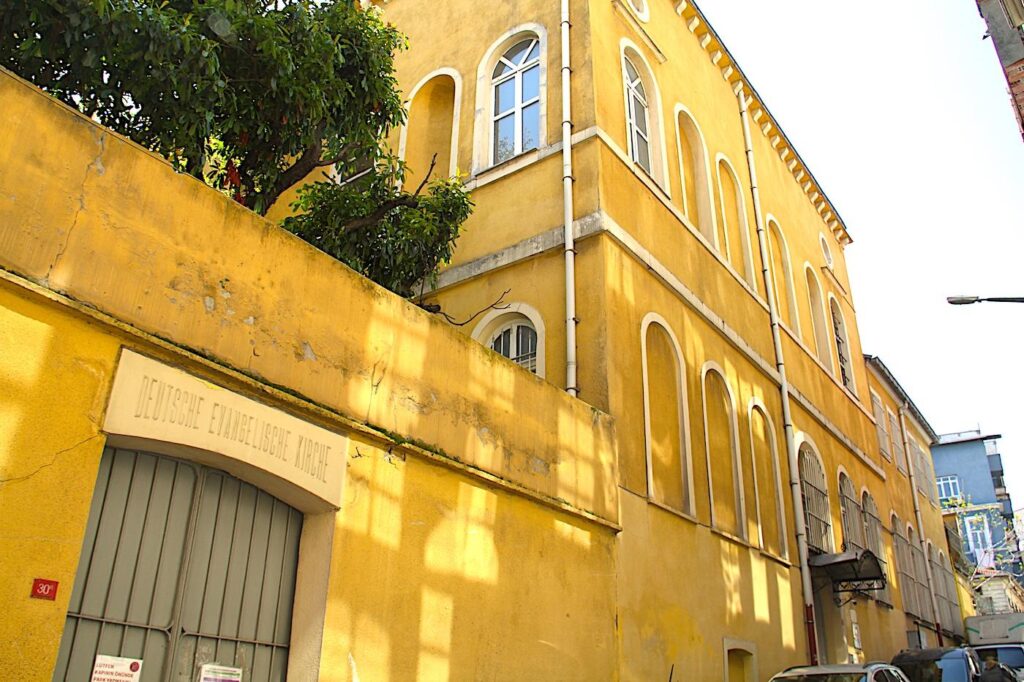
The Christuskirche is notable for its distinctive architectural style blends Romanesque Revival and Art Nouveau elements. The exterior features a prominent bell tower and a facade with decorative brickwork. Inside, the church boasts a spacious nave, stained glass windows, and a high, vaulted ceiling. The church’s religious significance lies in its role as a worship centre for the German-speaking Protestant community in Istanbul. It has served as a spiritual and cultural hub for Germans in the city for over a century and continues to do so today. The church belongs to the Evangelical Church in Germany, part of the Protestant tradition.
Ahrida Synagogue Balat – c. 1430, Sephardic Judaism.
Location: Ahrida Sinagogu, Ayvansaray, Kürkçü Çeşmesi Sk. No:7, 34087 Fatih/İstanbul. The official synagogue website. Opening Hours: By request only—see the form on their official website. Entrance Fee: Entry to the synagogue is free.
The Ahrida Synagogue, located in the historic Balat district of Istanbul, is one of the city’s oldest and most significant synagogues, dating back to the 15th century. Romaniote Jews who settled in the Ottoman Empire from Ohrid (modern-day North Macedonia) built the synagogue. Over time, it became a centre for the Sephardic Jewish community, particularly after the influx of Jews expelled from Spain in 1492. The synagogue has witnessed major historical events, including periods of decline and restoration, the most notable being its renovation in the 17th century under the influence of the Ottoman Baroque style. Despite centuries of change, Ahrida remains an active house of worship and a cultural symbol of Istanbul’s Jewish heritage.
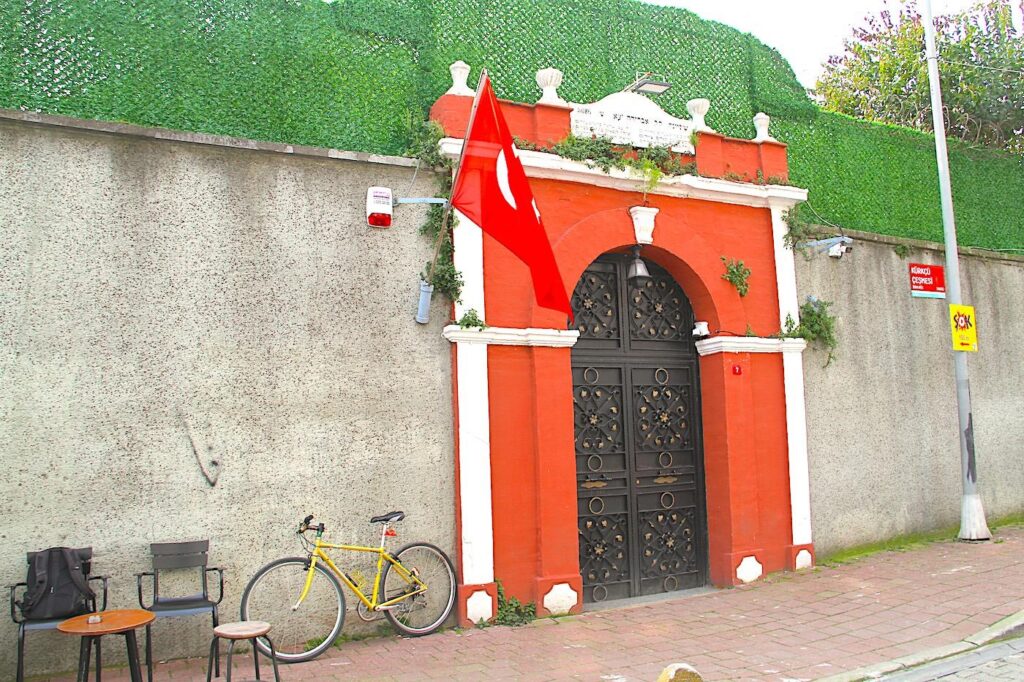
Architecturally, the Ahrida Synagogue is unique, especially for its boat-shaped bimah (pulpit), which is thought to symbolise either Noah’s Ark or the ships that brought Sephardic Jews to the Ottoman Empire. The synagogue’s design incorporates both Ottoman and European influences, featuring high ceilings, elaborate woodwork, and a central dome resembling those in classical Ottoman mosques. Later restorations have preserved its distinct character. Ahrida follows the Sephardic Jewish tradition, and its continued presence in Balat highlights the deep-rooted history of Jewish life in Istanbul. Today, it remains one of Türkiye’s most important Jewish religious sites, drawing visitors interested in spiritual practice and architectural heritage.
Bet Israel Synagogue Şişli – 1953, Ashkenazi Judaism.
Location: Şişli Beth İsrael Sinagogu, Cumhuriyet, Efe Sk. No:4, 34000 Şişli/İstanbul. The official synagogue website. Opening Hours: Monday-Friday: 09:00 – 17:00. Closed Saturdays and Sundays. Entrance Fee: Entry to the synagogue is free.
The Bet Israel Synagogue, located in the Şişli district of Istanbul, is one of the city’s largest and most prominent synagogues. It was constructed in the early 1950s, officially opening in 1953, to serve the growing Jewish population in the Şişli area. The synagogue was commissioned by the local Jewish community, who felt the need for a larger and more modern space to accommodate their religious and communal activities. The construction of Bet Israel reflects the post-World War II rebuilding efforts and the continued presence of the Jewish community in Istanbul.
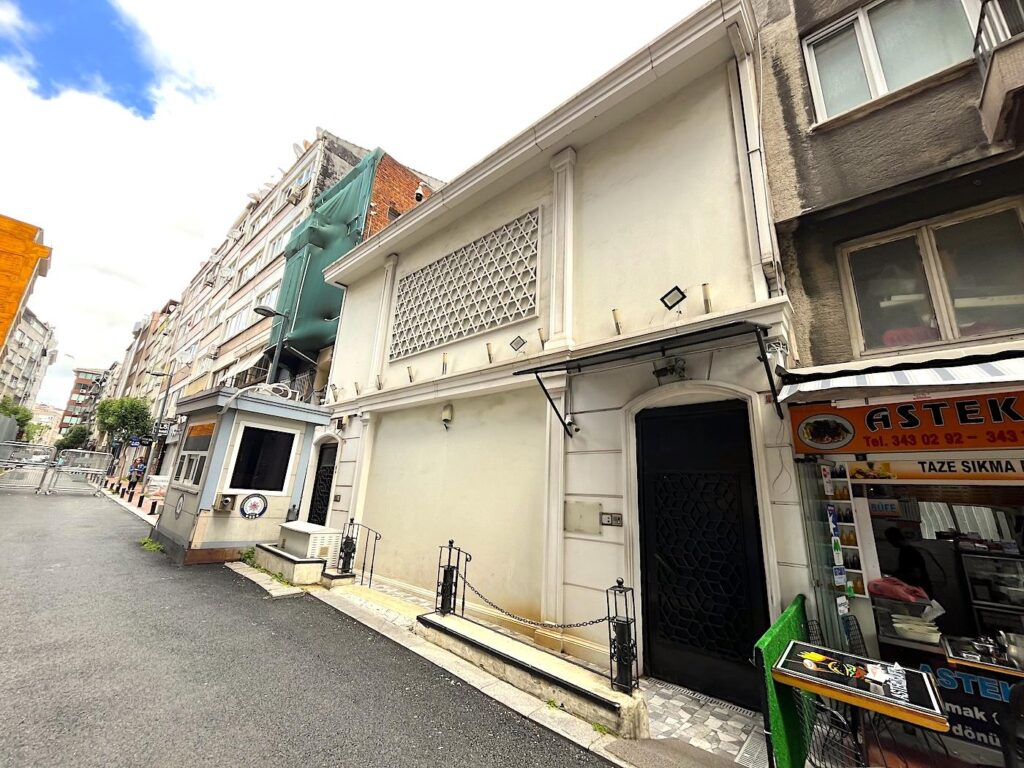
Bet Israel Synagogue is a substantial building, designed to accommodate a large congregation. Its architectural style is generally described as modern, though it incorporates some traditional elements of synagogue design. The interior features a spacious main sanctuary with a high ceiling and a large ark (Aron Kodesh) to house the Torah scrolls. A woman’s gallery is typically present, providing separate seating per traditional Jewish practice. The synagogue’s religious significance lies in its role as a major center of Jewish life in Şişli. It serves as a place of prayer, study, and community gatherings, hosting daily minyanim (prayer quorums), Shabbat services, and celebrations of Jewish holidays and life cycle events. The synagogue follows the Ashkenazi tradition of Judaism.
Other Notable Istanbul Churches & Synagogues
Church of St. Mary of Blachernae – Reconstructed in 1867, Greek Orthodox
Location: Vlaherna Meryem Ana Kilisesi, Ayvansaray, Kuytu Sk., 34087 Fatih/İstanbul. The official church website is unknown. Opening Hours: Daily: 09:00 – 17:00. Entrance Fee: Entry to the church is free.
The Church of St. Mary of Blachernae, located in Istanbul’s Ayvansaray district, is a significant Greek Orthodox sanctuary dating back to the mid-5th century. Empress Aelia Pulcheria initiated its construction around 450 A.D. near a sacred spring, a pilgrimage site near the Golden Horn. Following her death, Emperor Marcian completed the church. Emperor Leo I later enhanced the complex by adding the Ayía Sorós, a chapel housing revered relics such as the mantle and robe of the Virgin Mary, and the Ayion Loúsma, a sacred bath enclosing the holy spring. The original church was destroyed by fire in 1434. In 1867, the Guild of Orthodox Furriers constructed the small church on the same site, preserving its historical and spiritual significance. Architecturally, the original church was a large basilica featuring three aisles separated by colonnades, adorned with green jasper columns and gilded capitals.
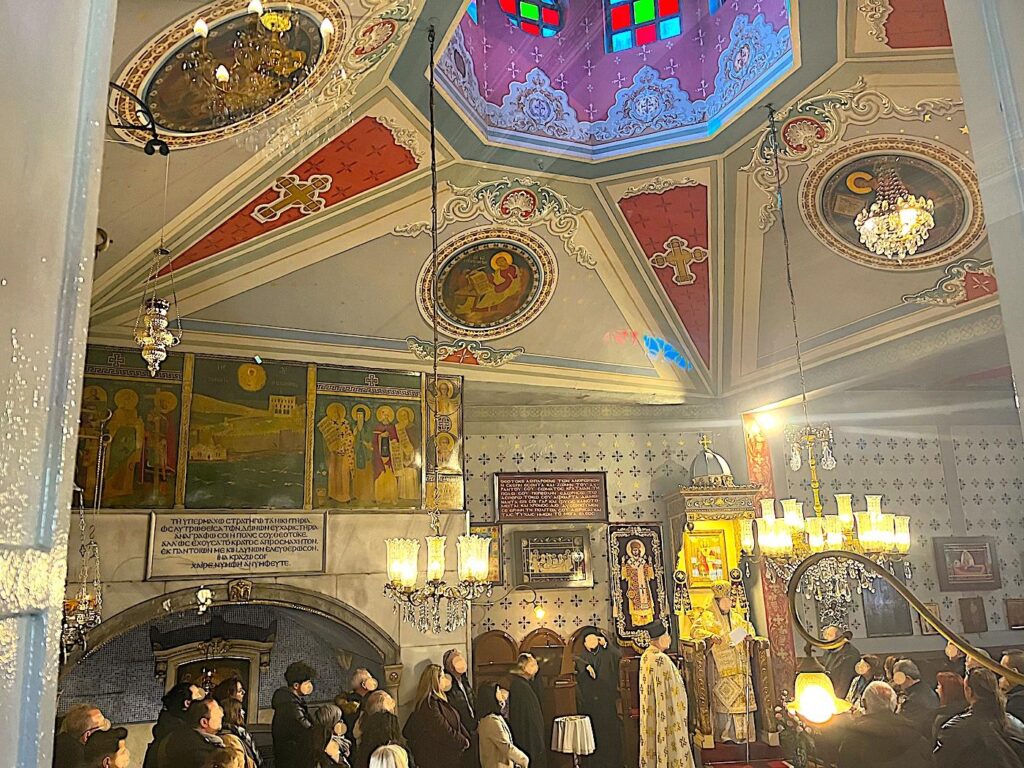

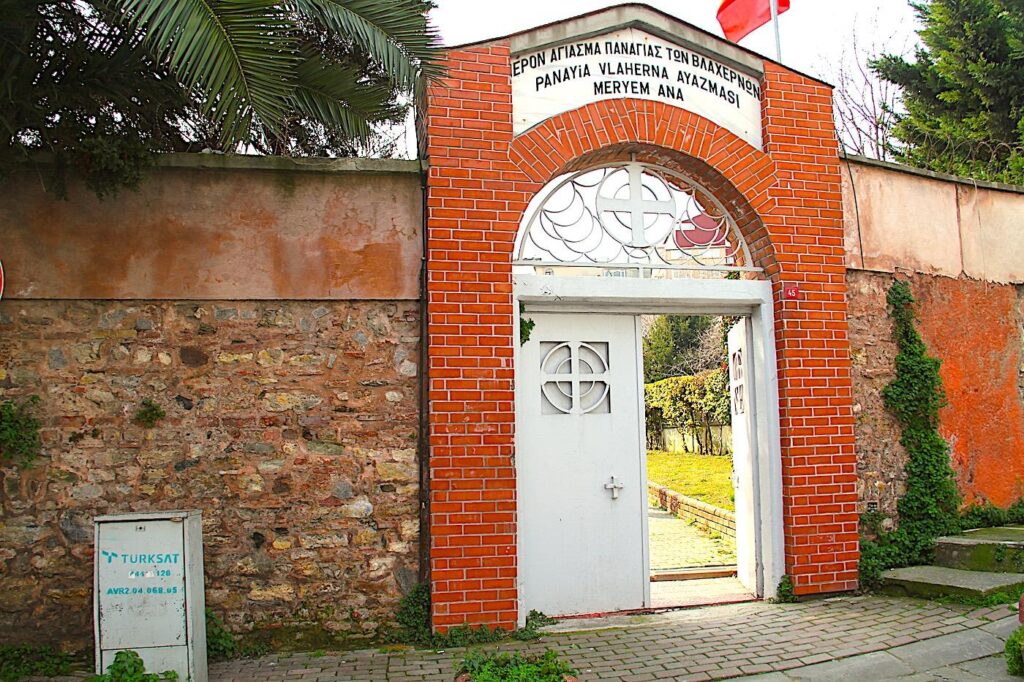
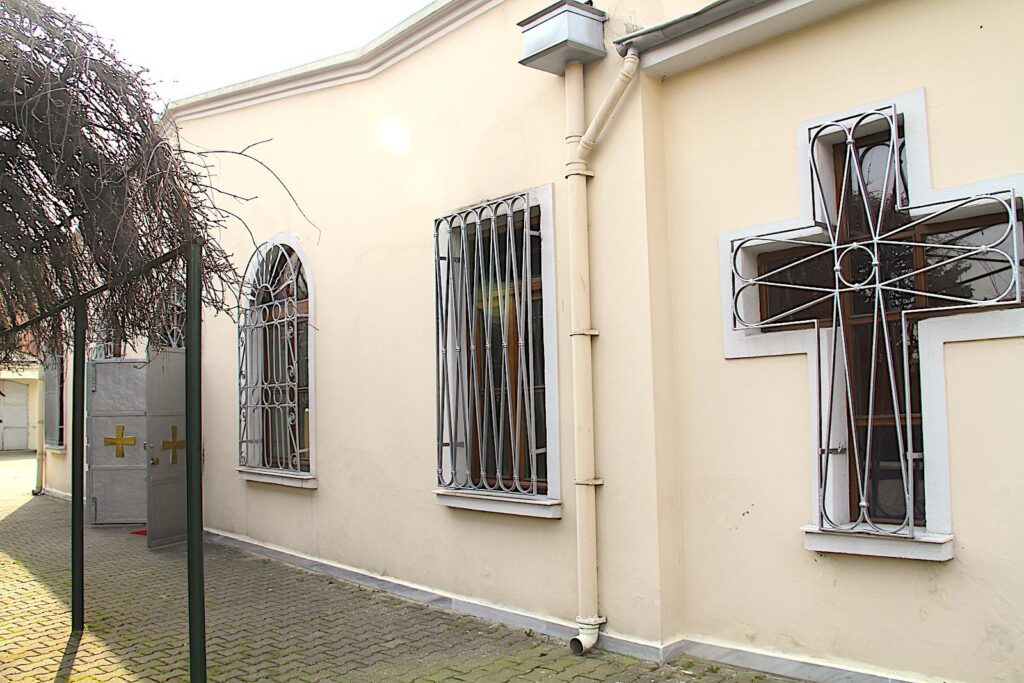
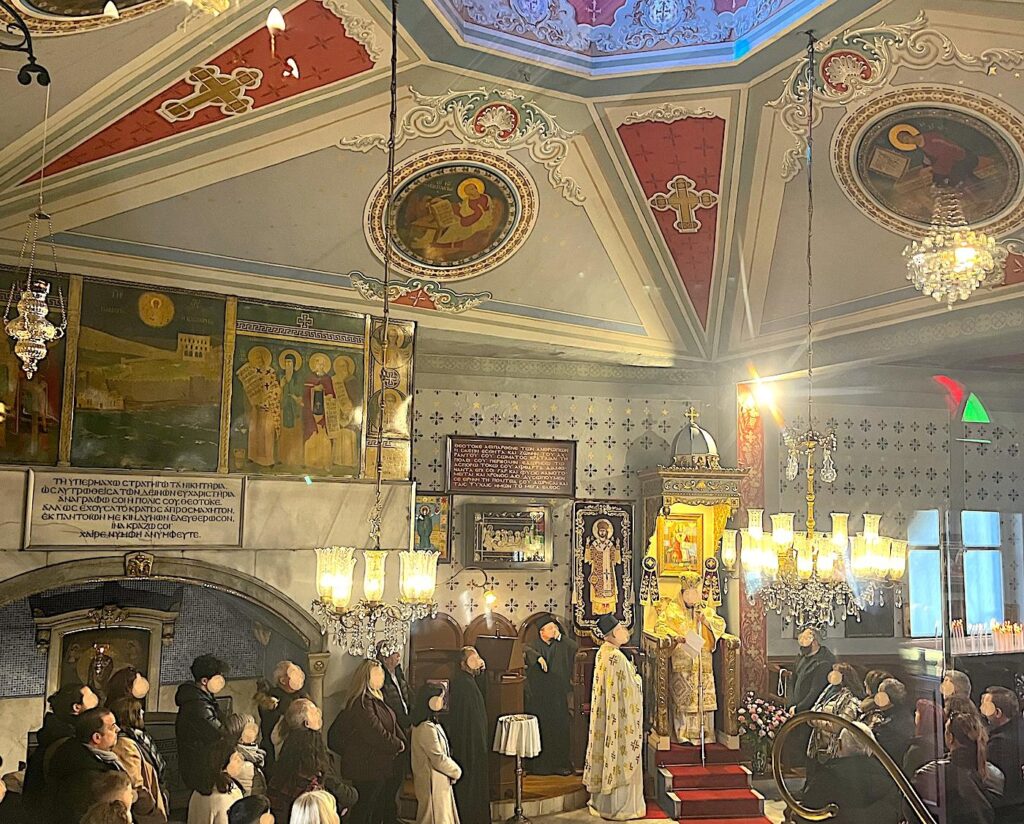
The current 19th-century structure is more modest, designed to enclose the sacred spring, which remains a focal point for pilgrims. Historically, the church holds profound religious importance, housing the revered icon of the Virgin Vlachernitissa and relics associated with the Virgin Mary. It was pivotal in Byzantine religious life, especially during sieges, where the relics were believed to protect the city. As a Greek Orthodox church, it continues to serve as a place of worship and pilgrimage. The church conducts regular services, with the Akathist Hymn traditionally sung every Friday morning. This hymn commemorates the protection believed to have been granted by the Virgin Mary during the siege of 626 A.D. Major religious holidays, particularly those honouring the Virgin Mary, such as the Feast of the Annunciation and the Dormition, are celebrated with special services.
Virgin Mary Orthodox Church & Fener Greek High School – 1281 Greek Orthodox
Location: Meryem Ana Rum Ortodoks Kilisesi, Balat, Firketeci Sk. No:1, 34087 Fatih/İstanbul, Türkiye. The official church website is unknown. Opening Hours: Unknown. Entrance Fee: Entry to the church is free if it is open.
The Virgin Mary Greek Orthodox Church (Panagia Mouchliotissa), also known as the Church of St. Mary of the Mongols, is a strikingly historic and spiritually significant site nestled in the Fener district on the hill above the Venerable Patriarchal Church of Saint George. Thanks to a firm decree (ferman) supposedly issued by Sultan Mehmed II after the Ottoman conquest, it is the only Byzantine church in the city that has never been converted into a mosque, preserving its original function as a place of Orthodox Christian worship since the 13th century. Maria Palaiologina, a Byzantine princess and the daughter of Emperor Michael VIII Palaiologos, built it in 1281. She had returned to Constantinople after a diplomatic marriage in the Mongol Empire. She founded the church, which became known as Mouchliotissa, a reference to her title as “Lady of the Mongols.”. The church houses beautifully aged icons and frescoes, and is tucked away from the main streets across the road from the prominent Greek High School.



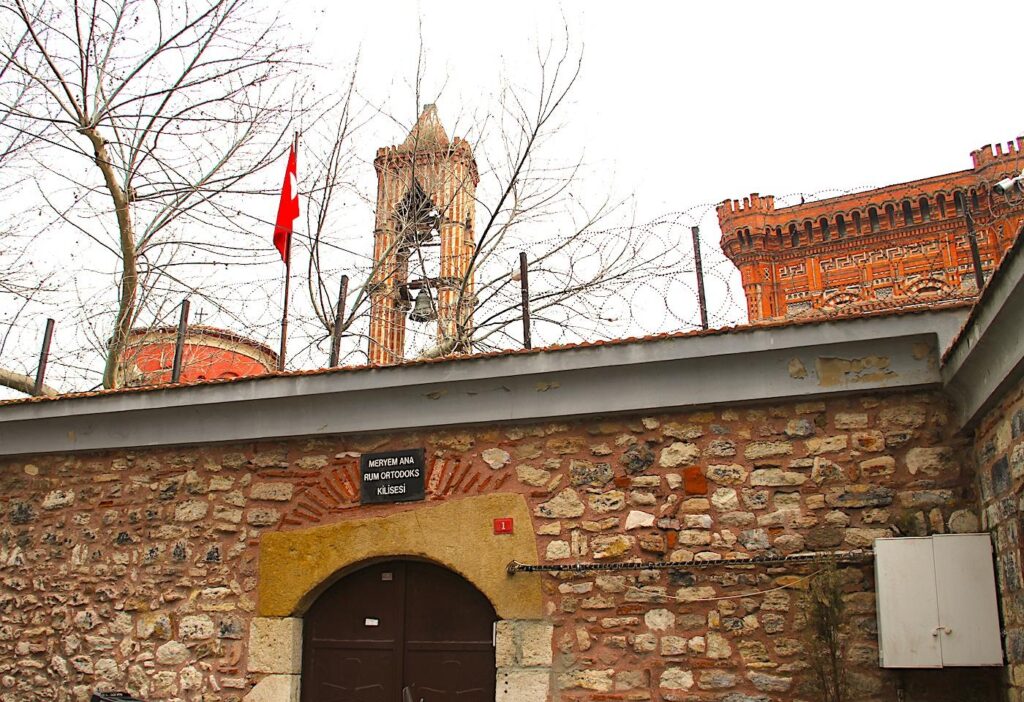
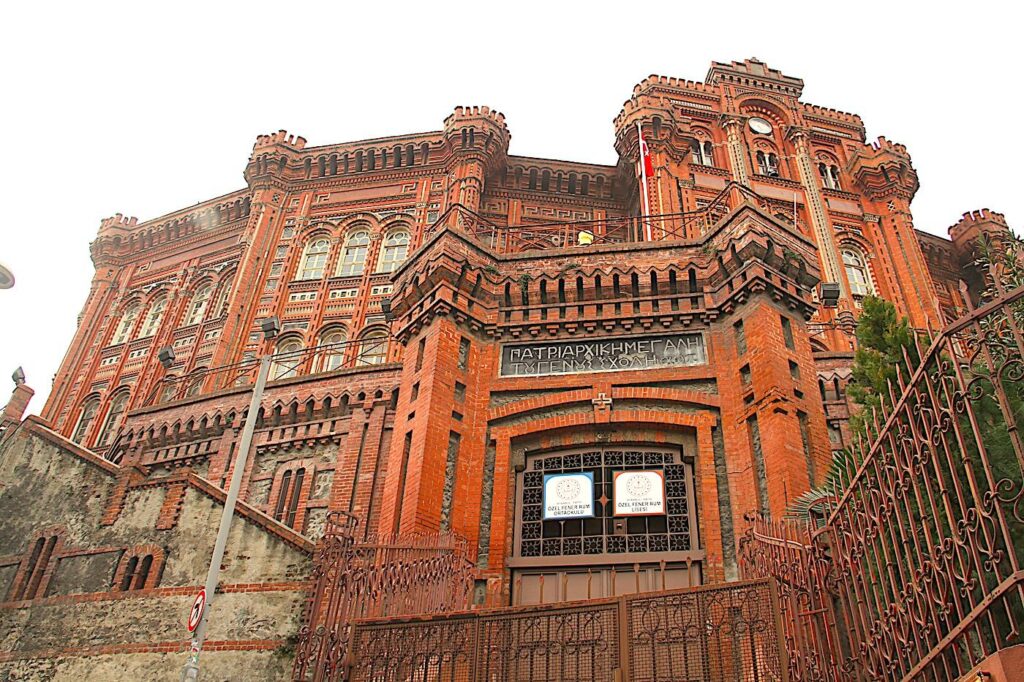
Towering just uphill from the church is the Fener Greek High School (Phanar Greek Orthodox College), an imposing red-brick structure often mistaken for a palace or fortress. Founded in 1454, shortly after the fall of Constantinople, it is one of the world’s oldest surviving Greek Orthodox schools. Its current Neo-Byzantine style building, constructed in the late 19th century, dominates the skyline with its dramatic towers and ornate detailing. The school has long served as a prestigious educational center for the Greek minority in Istanbul, producing generations of scholars, clergy, and intellectuals. Though the student body has dwindled, the institution remains a powerful symbol of the community’s cultural and academic legacy, watching over the Golden Horn like a vigilant sentinel of history.
Aya Andrea Russian Church – 1888, Russian Orthodox
Location: Aya Andrea Rus Kilisesi, Kemankeş Karamustafa Paşa, Mumhane Cd. 39b, 34425 Beyoğlu/İstanbul. The official church website is unknown. Opening Hours: Open for Sunday morning and Tuesday evening services as well as other Othodox relegious services. Entrance Fee: Entry to the church is free.
The Aya Andrea Rus Kilisesi, meaning “St. Andrew Russian Church,” is a unique and somewhat hidden gem in the Karaköy district of Istanbul. Its history is intertwined with the presence of Russian pilgrims and traders in the city. The church was built in the 19th century, with some sources suggesting 1888. It provided accommodation and a place of worship for pilgrims before the Russian Revolution, who travelled to holy sites like Jerusalem or Mount Athos (on the Aegean near Thessaloniki and Kavala). The church’s location, tucked away within a building complex, reflects the practical considerations of the time, where space in the bustling commercial district of Karaköy was at a premium.
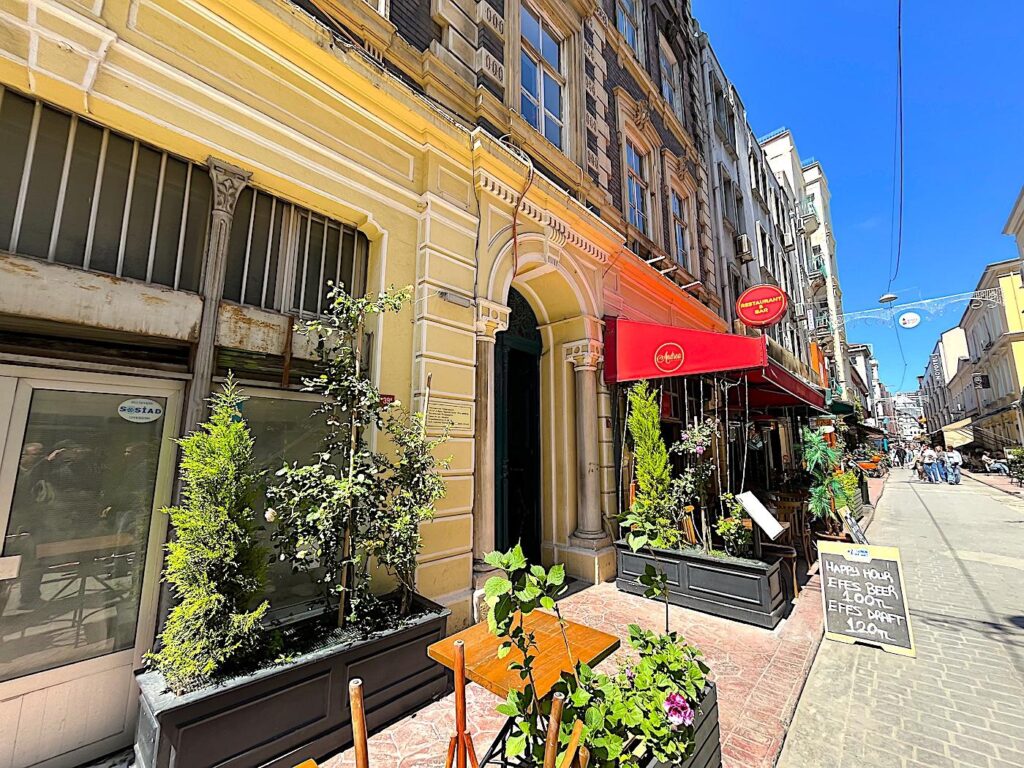

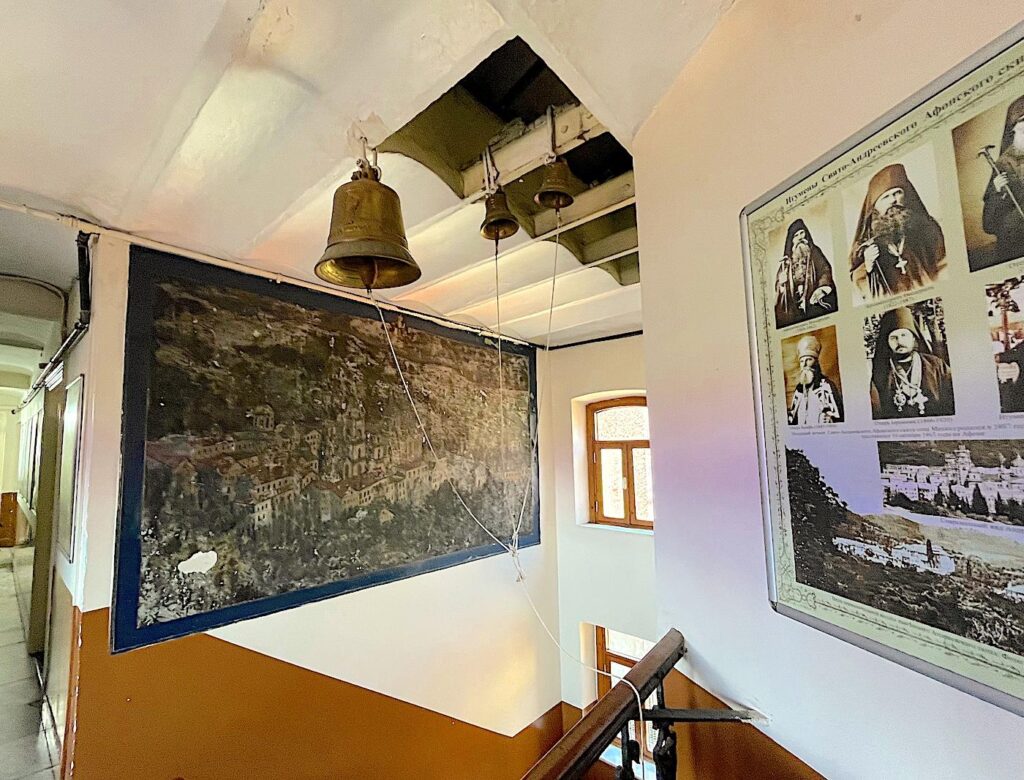

The Aya Andrea Rus Kilisesi is notable for its unusual architectural design. It’s often described as a “roof church” or “apartment church” because it’s situated on the upper floor of a building that initially served as a hostel or inn. This design was influenced by the limited space available in Karaköy and the need to integrate the church within an existing structure. Inside, the church features a modest but beautifully decorated chapel, adorned with icons and religious artwork. The murals in the chapel include those about the miracles of Saint Seraphim, one of the most venerated saints of Russia. The picture of the Monastery of Saint Andrea at Athos at the chapel’s entrance is in the Russian style.
An estimated 150,000 White Russians (anti-Bolshevik Russians) who fled their homeland after the 1917 Russian Revolution and subsequent Civil War, came to Constantinople primarily between 1919 and 1923 as refugees escaping the advancing Red Army. The city became a temporary haven due to its strategic location and historic ties with the Russian Orthodox Church. Among them was Ryazan-born artist Nikolay Konstantinovich Perov aka Nikolai Peroff (1883-1963), who contributed to the Russian Orthodox community by creating the murals and iconostases for churches, including the Aya Andrea Rus Kilisesi in 1928, which can be seen today in the church.
Saint Gregory the Illuminator Church of Galata – Reconstructed 1965, Armenian Apostolic.
Location: Surp Krikor Lusavoriç Ermeni Ortodoks Kilisesi, Hacımimi, Kemeraltı Cd. No:40, 34425 Beyoğlu/İstanbul. No known official church website. Opening Hours: TBC. Entrance Fee: Entry to the church is free.
Saint Gregory the Illuminator Church of Galata, located in Istanbul’s historic Galata district, is the city’s oldest surviving Armenian Apostolic church. Established in 1391 by an Armenian merchant named Kozma from Kaffa (now Feodosia) in Crimea, the church was built during the Genoese period, before the Ottoman conquest of Constantinople. The original structure suffered extensive damage over the centuries, particularly from fires in 1731 and 1771. It was demolished in 1958 to accommodate urban development plans. The current building, designed by architect Bedros Zobyan, was reconstructed between 1962 and 1965, with its official reopening in 1966.
Architecturally, the church is notable for adhering to traditional Armenian design, featuring a dome with a conical roof—unique among Istanbul’s churches. The interior once boasted rich decorations, including tiles from France, Italy, China, and Tunisia, reflecting the diverse influences over its history. Beneath the church lies the crypt of Patriarch Hovhannes Golod, adorned with black-and-white Kütahya and Dutch tiles. The church holds significant religious importance for the Armenian community in Istanbul, serving as a centre for worship and cultural preservation.
Armenian Evangelical Church – 1846, Armenian Eastern Protestant.
Location: Beyoğlu Aynalıçeşme Protestan Kilisesi, Kamer Hatun, Hamalbaşı Cd. No:44, 34435 Beyoğlu/İstanbul, Türkiye. No known official church website. Opening Hours: TBC. Entrance Fee: Entry to the church is free.
The Armenian Evangelical Church, also known as the Beyoğlu Aynalıçeşme Protestant Church, is a Protestant Christian denomination that emerged in the 19th century within the Armenian community of the Ottoman Empire. Established in 1848, it is recognised as the world’s first Armenian Evangelical church, marking a pivotal moment in the Armenian Protestant movement. Situated in the Aynalıçeşme neighborhood of Beyoğlu, adjacent to the German Protestant Church (1898), the church’s architecture reflects a blend of Gothic and neoclassical styles, featuring a modest yet dignified façade. Founded by a group of 40 reform-minded Armenian Christians who sought to emphasise personal faith, Bible reading, and congregational governance, principles influenced by the wider Protestant Reformation in Europe.
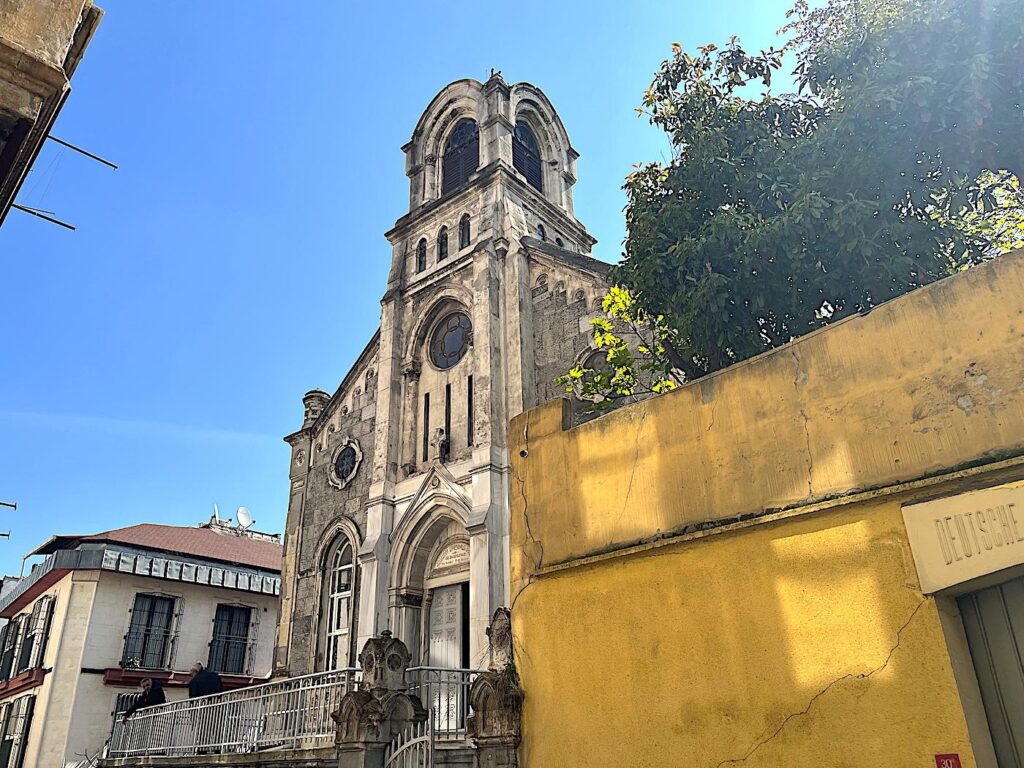
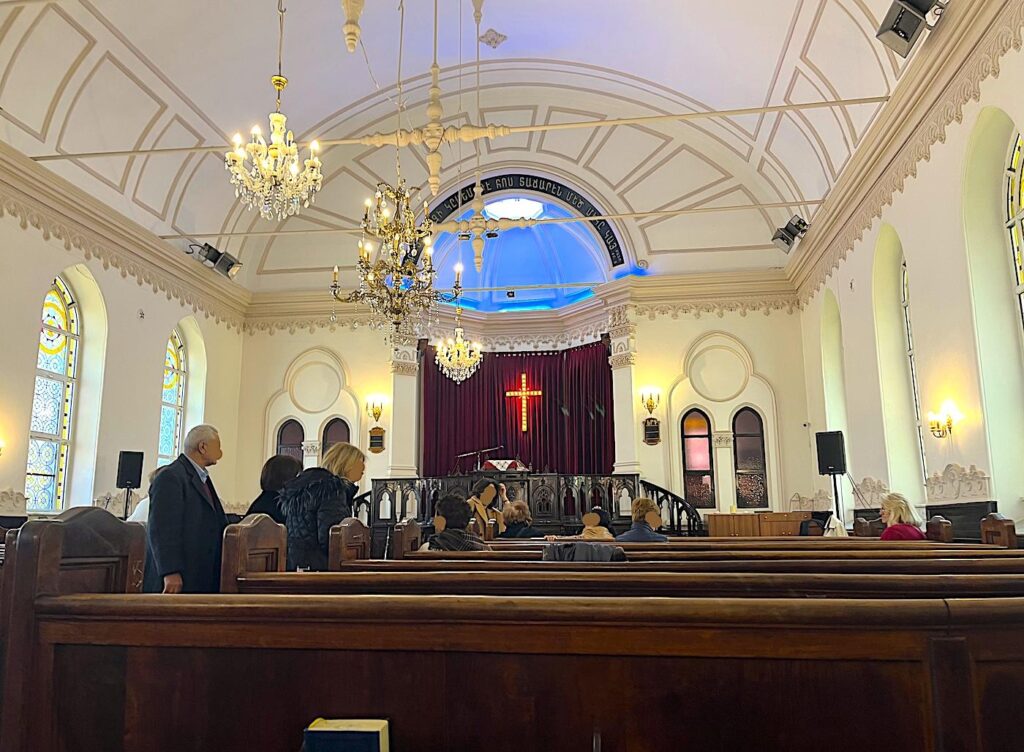
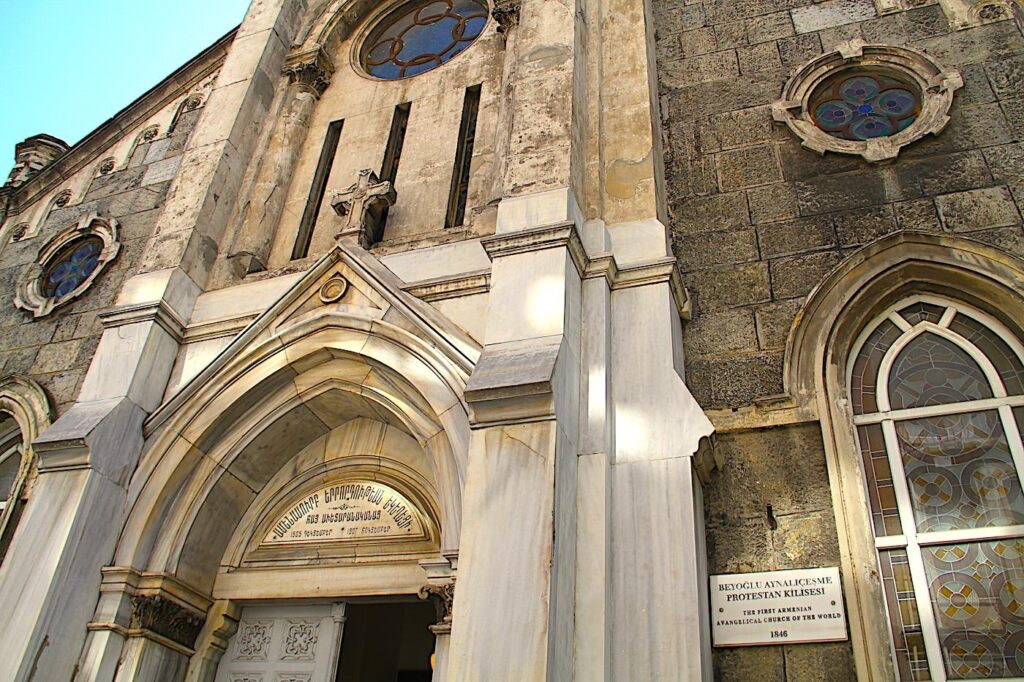
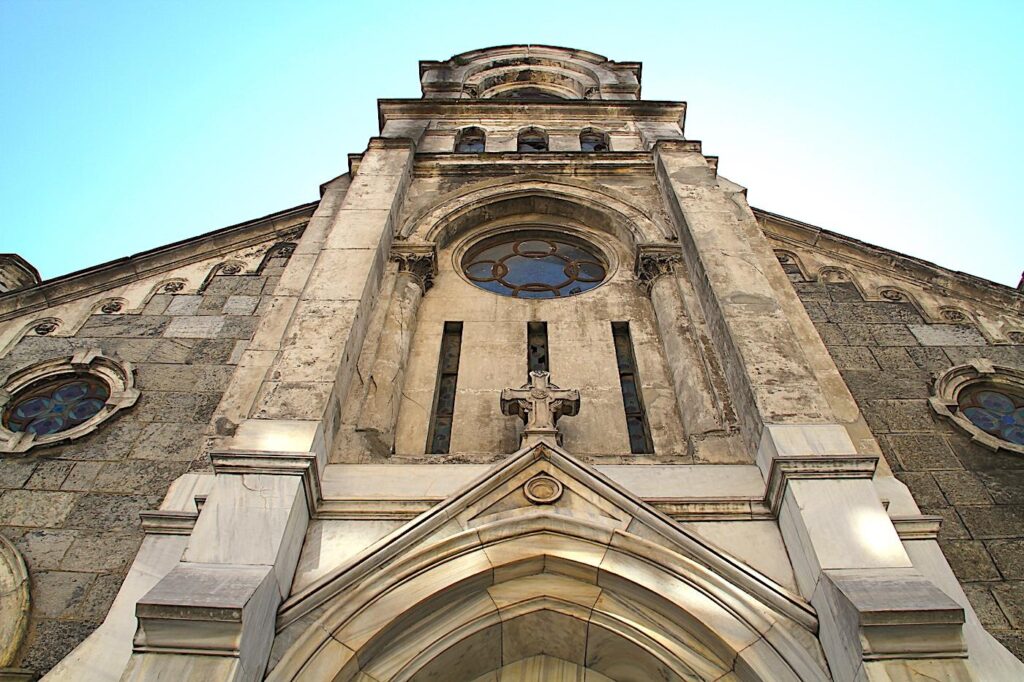
While the Armenian Protestant movement shares ethnic and cultural roots with the Armenian Apostolic Church (an Oriental Orthodox Church and the national church of Armenia), the Armenian Evangelical Church differs significantly in doctrine and practice. It emphasises salvation by faith alone, the authority of Scripture, and a more simplified liturgy. Services are typically held in Armenian and sometimes in the country’s local language where a congregation is based. Though a relatively small denomination, there are approximately 100 churches globally. The Armenian Evangelical communities are primarily found in countries with Armenian diasporas like Lebanon, the U.S., and France.
Neve Shalom Synagogue – 1951, Sephardic Judaism.
Location: Neve Shalom Synagogue, Bereketzade, Büyük Hendek Cd. No:61, 34445 Beyoğlu/İstanbul. The official synagogue website. Opening Hours: Sunday-Thursday: 10:00 – 16:00, Friday 10:00 – 12:00. Closed Saturdays. Entrance Fee: Entry to the synagogue is free.
The Neve Shalom Synagogue, meaning “Oasis of Peace,” is Istanbul’s largest and most prominent Sephardic synagogue. It was constructed in 1951 and designed by Turkish Jewish architects Elyo Ventura and Bernar Motola after the Jewish population in the Galata neighborhood grew significantly in the late 1930s. The synagogue was built on the site of a demolished Jewish primary school, reflecting the community’s desire for a central place of worship. Neve Shalom is a significant landmark for the Jewish community in Istanbul, serving as a hub for religious and cultural life.
The Neve Shalom Synagogue stands out for its modern architectural style, which incorporates elements of both traditional Sephardic synagogue design and contemporary influences. The interior features a large, open prayer hall with a central dome and a women’s balcony that surrounds three sides of the sanctuary. The stained-glass windows above the ark were imported from England and add to the beauty of the space. The synagogue’s design allows for ample seating and creates a sense of community during services. Neve Shalom holds immense religious significance as the central Sephardic synagogue in Istanbul, hosting regular services, especially on Shabbat, High Holidays, and life cycle events like bar mitzvahs, weddings, and funerals.
Aya Panteleymon Church – 1871, Russian Orthodox.
Location: Aya Panteleymon Kilisesi , 6 Kemankeş Karamustafa Paşa Hoca Tahsin Sokak, Karaköy, D:19, 34425 Beyoğlu/İstanbul. No known official church website. Opening Hours: Wednesday – Monday with services at 08:00 and 16:00 (TBC), closed Tuesdays. Entrance Fee: Entry to the church is free – you need to ring the bell to enter (4 and 🔔 or call 0212 224 1206).
Aya Panteleymon Kilisesi, also known as the Church of St. Panteleimon, is a small yet historically significant Russian Orthodox church on the 6th-floor rooftop of a 19th-century inn in Istanbul’s Karaköy district. Built in 1871 to serve Russian pilgrims travelling to the Holy Land and Mount Athos, it was part of a larger network of Orthodox infrastructure in the city. This modest chapel, hidden amid the rooftops of a bustling commercial area, is distinguished by its traditional iconostasis, Russian liturgical decoration, and a deeply spiritual ambience that has endured through changing times. It reflects the longstanding connection between Orthodox Russia and Constantinople, the seat of the Ecumenical Patriarchate.
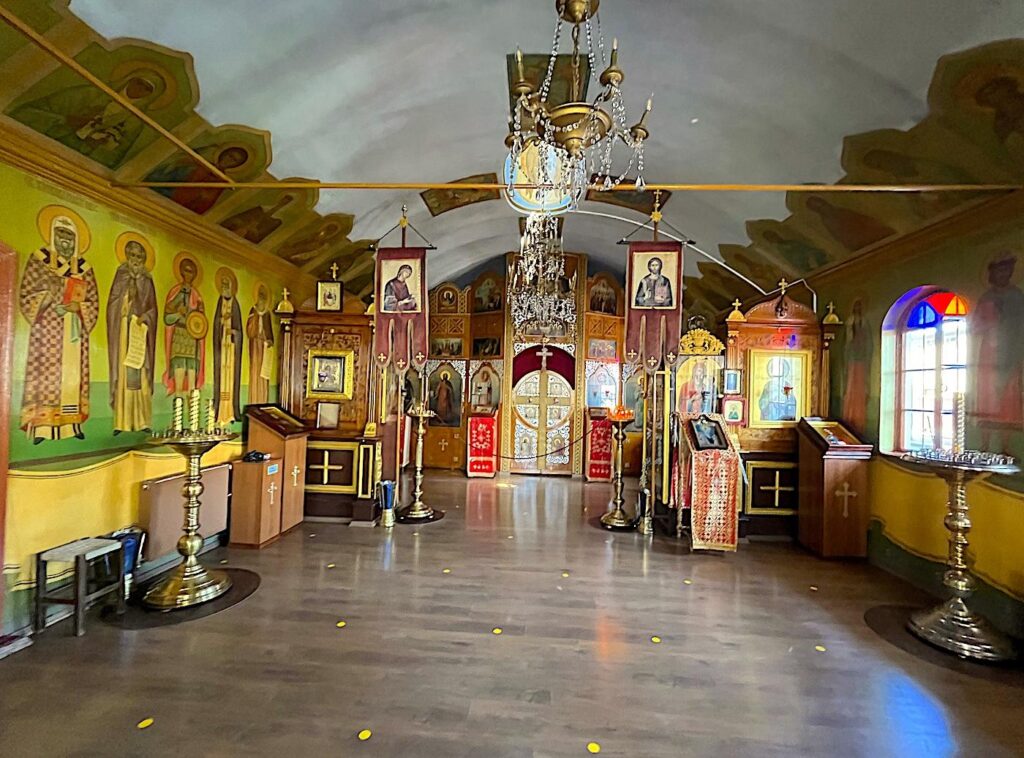
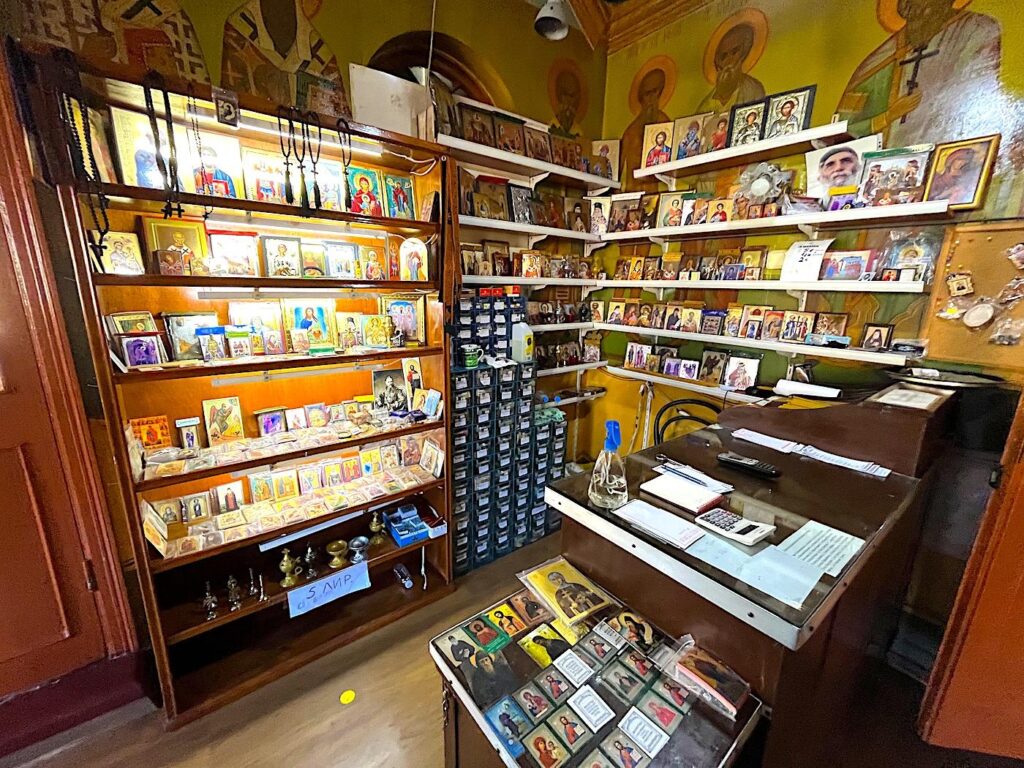
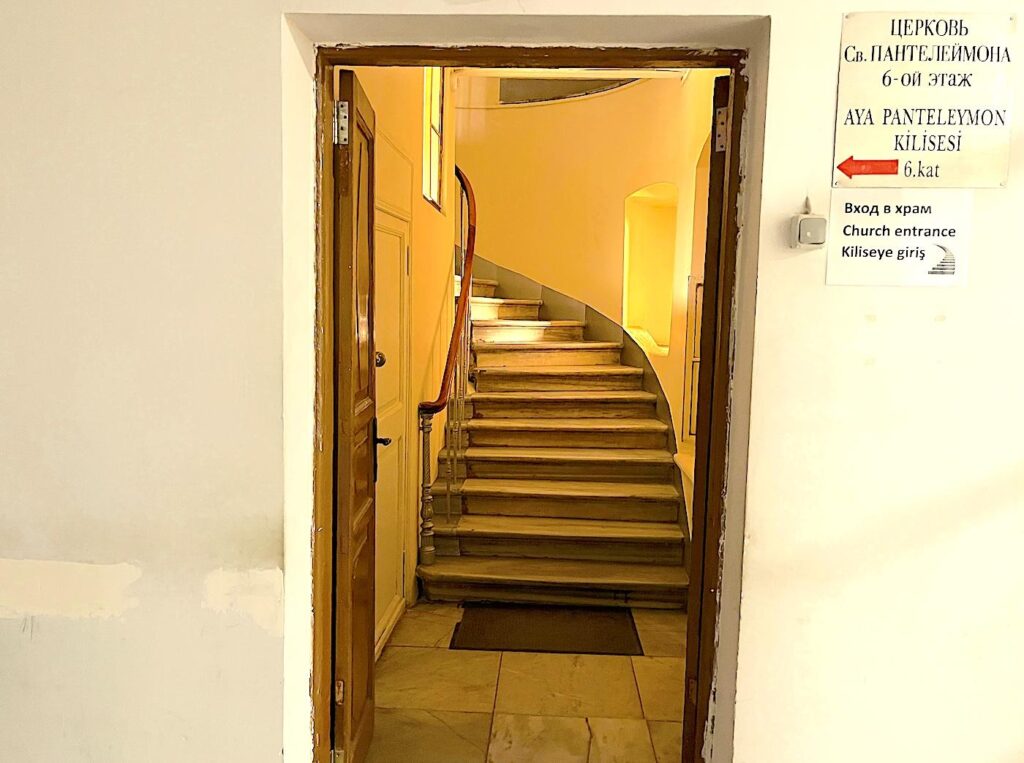

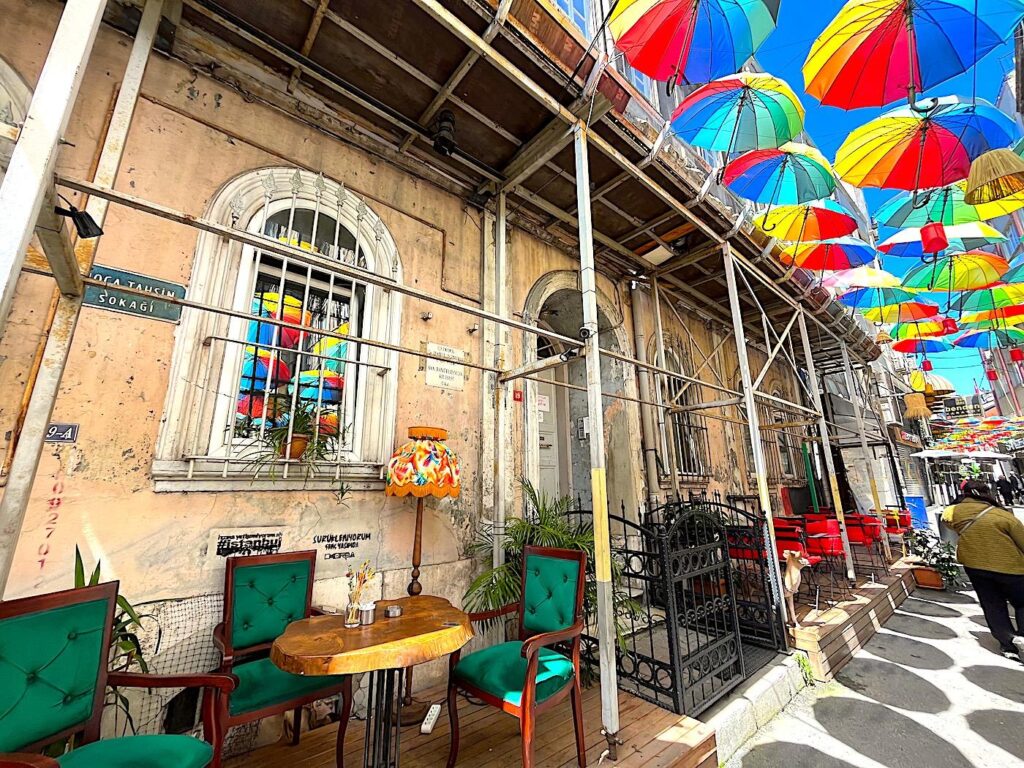
The church took on new significance following the Russian Revolution of 1917, when thousands of White Russians, those loyal to the tsarist regime and opposed to Bolshevik rule, fled the violence of the Russian Revolution. Many found temporary refuge in Istanbul, then under Allied occupation after World War I. These refugees included military officers, aristocrats, clergy, and artists, who brought with them both trauma and cultural depth. For the Russian émigré community, Aya Panteleymon Kilisesi became a spiritual anchor and gathering place, offering solace in exile and preserving a sense of religious continuity. It also hosted memorial services for those lost during the Revolution and the following perilous exodus.
Today, the church remains an active place of worship under the auspices of the Ecumenical Patriarchate. Daily liturgies are still held, and the church welcomes both worshippers and visitors curious about its history. The church is affiliated with the St. Panteleimon Monastery on Mount Athos, a significant centre of Russian Orthodoxy, further emphasising its importance to the Russian Orthodox diaspora. In the early 2000s, the church underwent a restoration that included the addition of new frescoes painted by an artist from Moscow.
Former Istanbul Churches now Active Mosques or Museums
See also: LikeTürkiye.com – Top 10 Mosques
The conversion of churches to mosques in Istanbul began with the Ottoman conquest of Constantinople in 1453 and continued periodically thereafter. Following the conquest, many prominent Byzantine churches, including Hagia Sophia, were immediately transformed into mosques, symbolising the new Islamic rule. This initial wave of conversions often involved physically altering the structures, such as covering mosaics and frescoes, adding minarets, and reorienting the interior towards Mecca. While some churches were converted relatively soon after the conquest, others remained in Christian use for varying periods before eventually being designated as mosques, often due to strategic or political considerations.
Under Atatürk and the early Republic, several historic mosques that were originally Byzantine churches, most notably Hagia Sophia and Chora, were converted into museums as part of Turkey’s secularisation efforts. Under Recep Tayyip Erdoğan’s presidency, these museums were reverted to functioning mosques, with Hagia Sophia being reconverted in 2020 and Chora in 2023.
Hagia Sophia (Ayasofya-i Kebir Cami-i Şerifi, Sultan Ahmet) – 537 A.D.
Location: Ayasofya-i Kebir Cami-i Şerifi, Sultan Ahmet, Ayasofya Meydanı No:1, 34122 Fatih/İstanbul. The official site website link (Turkish only) and the official Turkish Museums website. Opening Hours: Daily: 09:00 – 19:30. On Friday, the Hagia Sophia is typically closed for noon prayers from 12:30 until 14:30. Entrance Fee: The full-price adult (over 8 years old) entrance fee in February 2025 was €25.00.
Notes on Entrance: As of January 2024, Hagia Sophia has two entrances. The one on Sultanahmet Square is now exclusively for Turkish citizens visiting the worship area in the former narthex and nave. To better manage the over-tourism and visitor flow and preserve Hagia Sophia’s sanctity as a functioning mosque, new rules have been implemented, primarily separating tourist visits from prayer. Tourists now enter on the northeast side near the Fountain of Sultan Ahmet III through a designated entrance to the upper-level galleries. At the same time, the ground floor is reserved for worshippers. This separation, along with introducing an entrance fee for tourists, aims to reduce crowding, maintain a respectful atmosphere for those praying, and aid in preserving this historical and religious site. Women visitors must also wear a headscarf before they enter the upper gallery.
Commissioned by Byzantine Emperor Justinian and consecrated in 537 as a Christian basilica, Hagia Sophia stood as the pinnacle of Byzantine architectural achievement for nearly a millennium. Its magnificent dome, a marvel of engineering for its time, and its intricate mosaics spoke to the grandeur of the Byzantine Empire. Following the Ottoman conquest of Constantinople in 1453, Hagia Sophia was converted into a mosque, adding minarets and Islamic calligraphic inscriptions, reflecting the new rulers’ faith. After establishing the Turkish Republic as part of his secularisation policy agenda, founding President Atatürk turned Hagia Sophia into a museum in 1935. 85 years later, President Erdoğan ordered that the Hagia Sophia be reconverted into a mosque, “Ayasofya-i Kebir Cami-i Şerifi,” which opened for prayers on 24 July 2020.
The architectural features of Hagia Sophia are genuinely breathtaking. Its most iconic element is the massive central dome, which creates a sense of awe-inspiring space. Using pendentives to support the dome was a revolutionary engineering technique, allowing for a seamless transition from the square base to the circular dome. The building has exquisite marble columns, intricate mosaics, and vast open spaces. These elements combine to create a sense of both grandeur and spiritual reverence. Blending Byzantine and Ottoman architectural styles further enhances the building’s unique character. The visible signs of Christianity and Islam within the building powerfully remind visitors of its complex past. Hagia Sophia’s sheer scale, rich history, and artistic treasures make it a remarkable and significant landmark. It is a place where history, art, and faith converge, offering visitors a glimpse into the past and a sense of wonder.
To maximise your Hagia Sophia experience, aim for early mornings on weekdays, such as Tuesdays or Wednesdays, avoiding Fridays due to noon prayers, to ensure entry. During the spring or autumn, shoulder seasons are a time to avoid peak crowds and enjoy pleasant weather. Under the rules implemented in January 2024, professional guides can no longer give tours inside the Hagia Sophia. Instead, visitors can scan a QR code on their phone (or rent headsets) to access an audio-visual tour. The tour offers details on 10 points of interest in over 20 languages.
Hagia Irene (Aya İrini) – C6th
Location: Aya İrini, Cankurtaran, Topkapı Sarayı No:1, 34122 Fatih/İstanbul. The official Ministry of Culture website. Opening Hours: Daily: 09:00 – 17:30. Entrance Fee: The full-price adult entrance fee in February is the TL equivalent of 2025 is €20.00.
Hagia Irene, meaning “Holy Peace,” is a historically significant church in the outer area of Istanbul’s Topkapi Palace complex. Its origins date back to the 4th century, during the reign of Emperor Constantine the Great, making it one of the oldest Byzantine churches in the city. While the original church was likely damaged or destroyed over time, Emperor Justinian rebuilt and expanded it in the 6th century. Hagia Irene’s long and rich history is intertwined with the development of early Christianity in Constantinople.
Hagia Irene stands out for its relatively austere and unadorned architectural style, especially compared to the grandeur of Hagia Sophia. It features a basilica plan with a large central dome and two side aisles. The interior is notable for its simple yet powerful design, focusing on spaciousness and light. The church’s historical significance is immense, as it served as Constantinople’s patriarchal cathedral before the Hagia Sophia’s construction. It also influenced critical events, such as the Second Ecumenical Council in 381 AD. While it’s no longer an active church, Hagia Irene remains a vital historical landmark, offering insights into early Byzantine architecture and the development of Christianity.
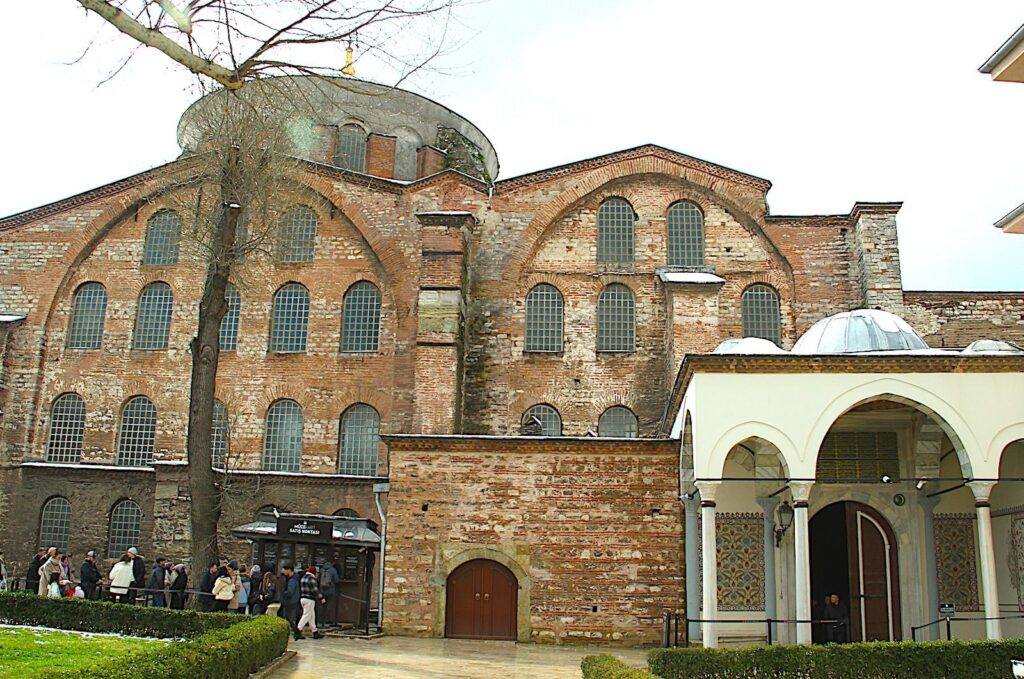
It is no longer affiliated with any active religious denomination. Hagia Irene is a museum open to the public as part of the Topkapi Palace Museum complex. There is an entrance fee to the Topkapi Palace, which includes access to Hagia Irene. Regular religious services are not held as it is no longer a functioning church; however, its historical significance is recognised and sometimes used for concerts and special events.
Church of the Holy Saviour in Chora (Kariye Camii) – C14th
Location: Kariye Camii, Derviş Ali, Kariye Cami Sk. No:18, 34087 Fatih/İstanbul. The official Presidency of Religious Affairs website link (Turkish only), and the official Turkish Museums website. Opening Hours: Saturday – Thursday: 09:00 – 17:55, closed Friday. Entrance Fee: The full-price adult entrance fee in February 2025 is €20.00.
The Kariye Mosque, originally the Church of the Holy Saviour in Chora, is a Byzantine-era church renowned for its exquisite mosaics and frescoes. Constructed and reconstructed over centuries, its most significant form dates back to the 14th century, under the patronage of Theodore Metochites, a wealthy scholar and statesman. During the Ottoman conquest of Constantinople in 1453, the church was converted into a mosque known as the Kariye Camii. In 1948, it was secularised and turned into a museum, allowing its magnificent Byzantine artwork to be revealed and studied. In 2020, it was again converted into a mosque, sparking international debate due to its historical and artistic importance.
The Chora Church’s architectural features are a testament to Byzantine artistry. Its compact structure houses a rich collection of mosaics and frescoes depicting scenes from Christ’s life, the Virgin Mary, and Old Testament stories. These artworks are considered some of the finest examples of late Byzantine art, showcasing a high level of detail, expression, and narrative skill. The church’s interior is divided into several sections, including the narthex, nave, and parecclesion, each adorned with intricate mosaics and frescoes. The building combines different architectural styles, reflecting the various periods of its construction and restoration.
Recent restoration work has focused on preserving the mosaics and frescoes, as well as adapting the building for its new function as a mosque. This has included the installation of carpets for prayer and covering certain mosaics during prayer times, in accordance with Islamic tradition. The Kariye Mosque reopened for worship in 2022. Entry is free for worshippers, but a fee applies for tourists. Opening hours are subject to change based on prayer times, so it’s best to check the current schedule before visiting. Foreigners must observe the same rules as all visitors: respectful attire is required (covering shoulders, knees, and hair for women), and shoes must be removed before entering. Photography is generally allowed, but visitors should be mindful and avoid disrupting worshippers during prayer.
Church of Theotokos Kyriotissa (Kalenderhane Camii) – late C12th
Location: Kalenderhane Camii, Kalenderhane, 16 Mart Şehitleri Cd. No:11, 34134 Fatih/İstanbul. No known official mosque website. Opening Hours: TBC. Entrance Fee: Entry to the church is free.
The Kalenderhane Mosque, located near the Aqueduct of Valens in Istanbul’s Fatih district, is a remarkable example of a Byzantine church repurposed into a mosque during the Ottoman period. Originally constructed as a Byzantine church dedicated to Theotokos Kyriotissa in the 12th century (circa 1150 – 1180) during the reign of the Komnenian emperors, it served as a religious and monastic site. Following the Ottoman conquest of Constantinople in 1453, the building was converted into a mosque and given the name “Kalenderhane” because it was assigned to a dervish order known as the Kalenderis, an ascetic Sufi group. This transformation reflects the broader Ottoman practice of adapting Byzantine structures for Islamic worship, blending the city’s Christian and Muslim legacies.

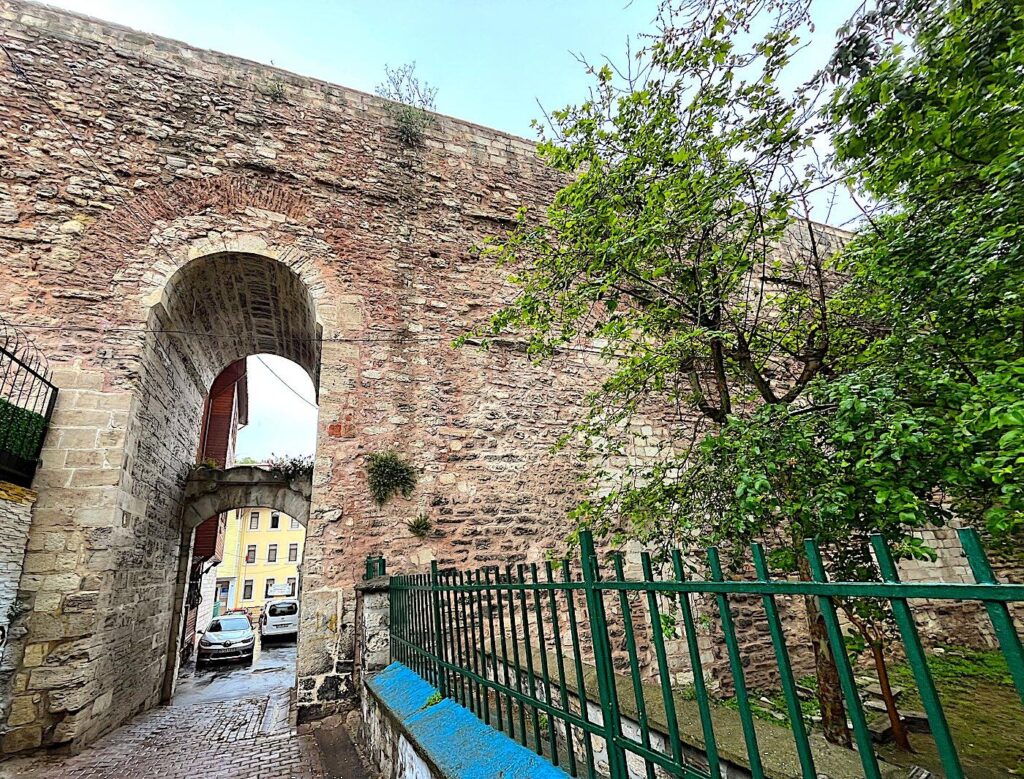
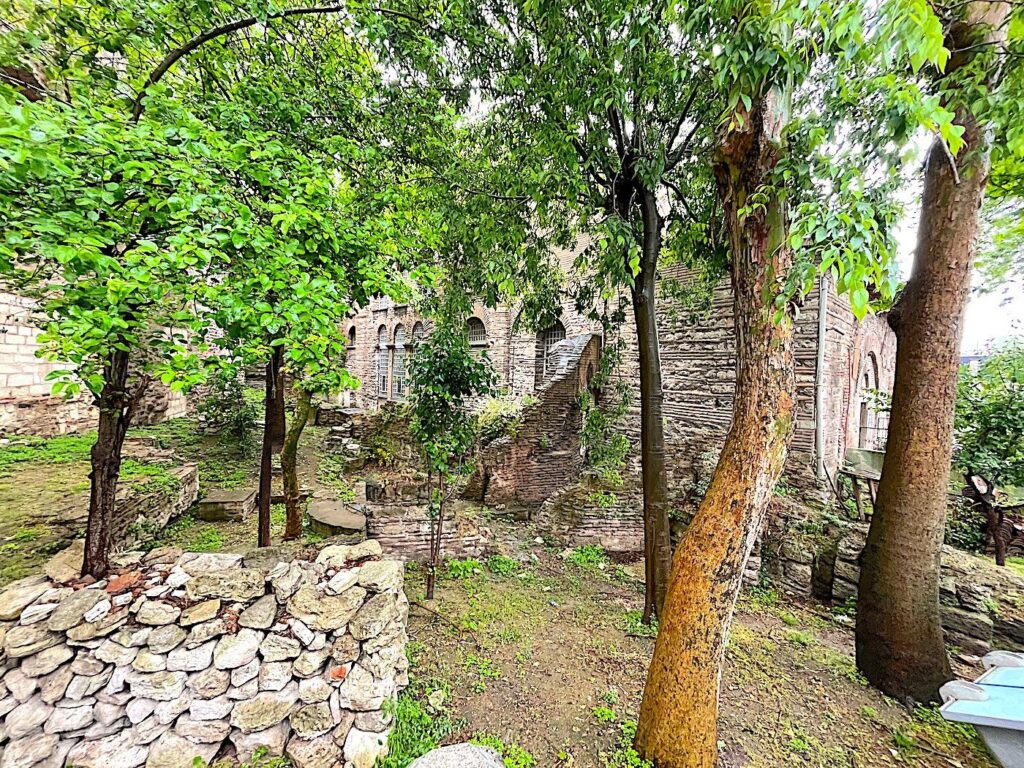
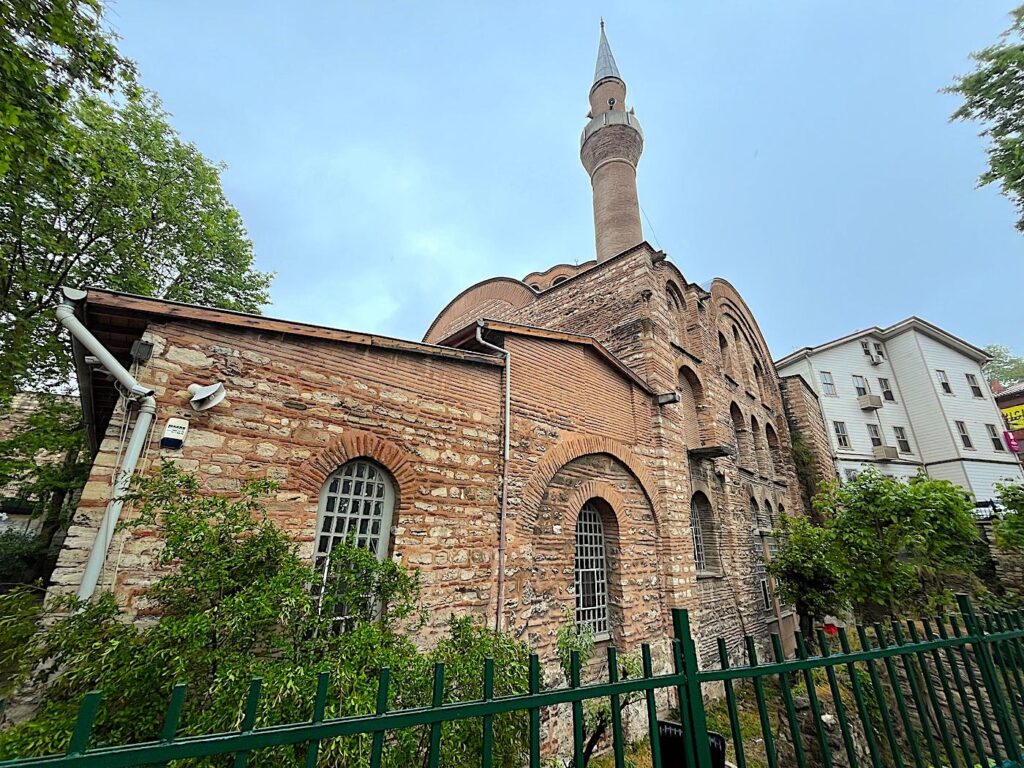
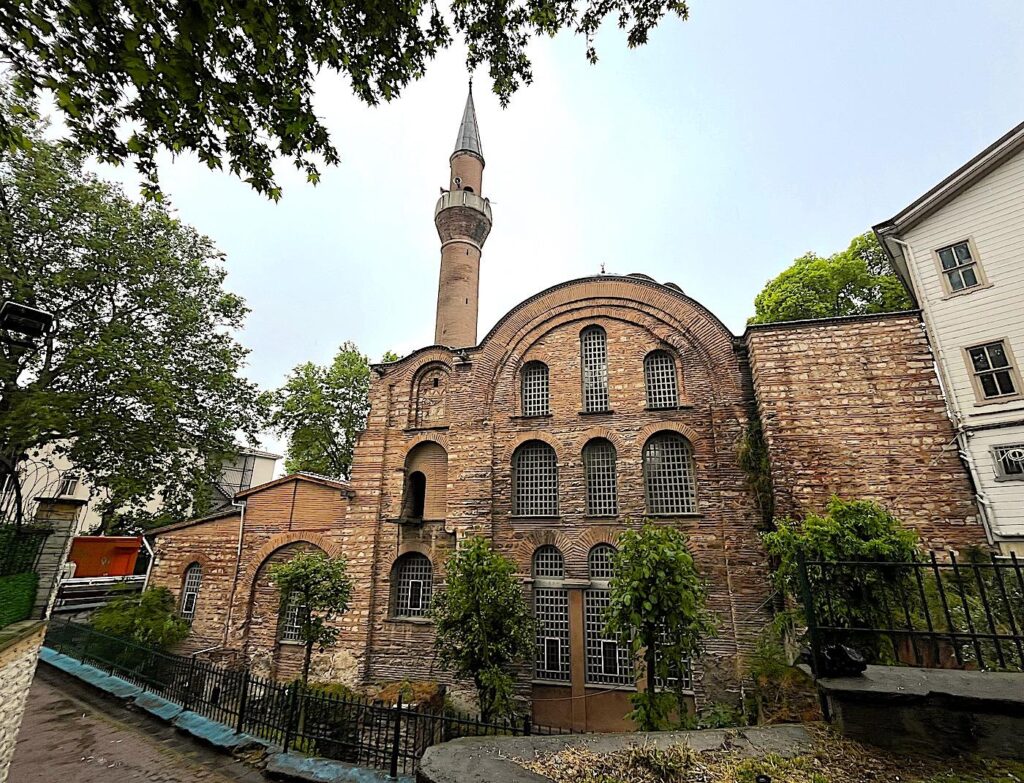
Architecturally, the Kalenderhane Mosque is a textbook example of middle Byzantine domed architecture. The main structure follows a Greek cross-in-square plan with a central dome supported on pendentives and four piers. Its brick and stone masonry is laid in the characteristic Byzantine “cloisonné” style, alternating horizontal rows of brick and stone for both structural and decorative purposes. The interior features marble panels, capitals with fine carving, and remnants of original Byzantine frescoes, particularly in the side chapels; an exceptionally rare survival in Istanbul. These elements provide scholars with valuable insights into 12th-century Byzantine religious art and architecture.
The mosque underwent extensive restoration in the 20th century, following centuries of damage from fires, earthquakes, and neglect. Turkish and international archaeologists uncovered and preserved many of its original Christian elements, including mosaics and frescoes, while maintaining its function as a mosque.
See also: LikeTürkiye – Best of Istanbul Top 10 Mosques
